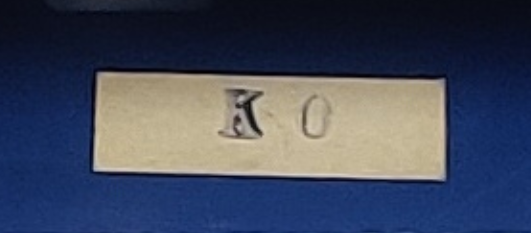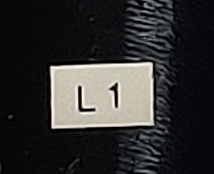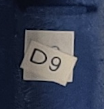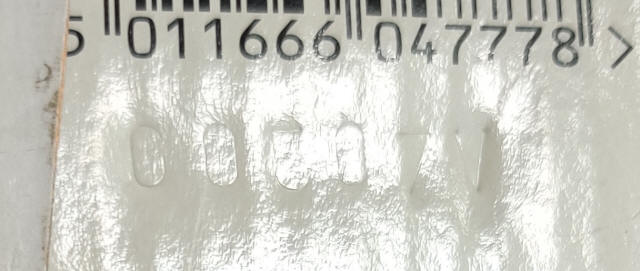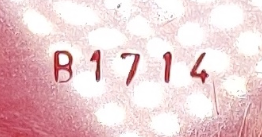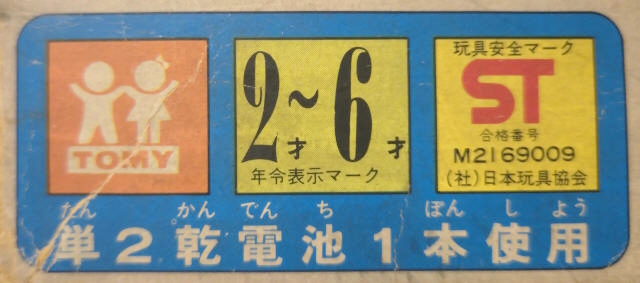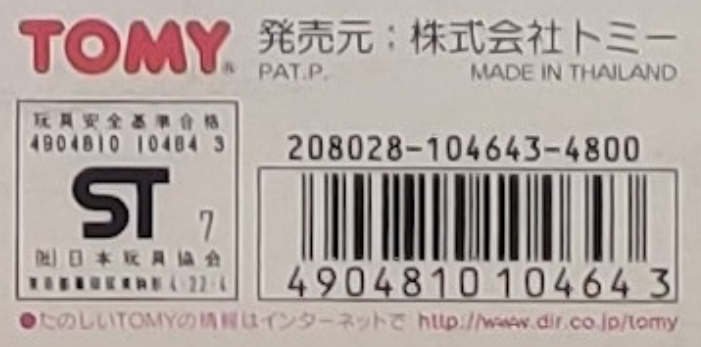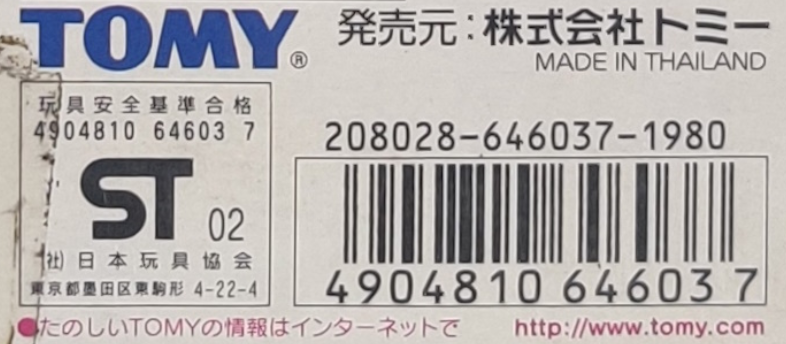fall inside a hole
Plarail Dating and Identification
There have been so, so many releases, rereleases, reprints, reissues, tooling changes and set variants that identifying any given Plarail and where it came from can be a large task, especially if you are only looking at a few auction photos online. There are a number of indicators and trends that can help to identify the time period a Plarail train or component comes from, but many are best-observed in-hand. Note that not all of these are hard rules, and if you hunt hard enough you will always find exceptions on one technicality or another - finding all of these is half the fun of exploring new Plarail.
Many of these trends are also seen on other Tomy toys produced at different periods of time, and the information about material choice, box date numbers, and regions of manufacturing also apply to many other Tomy toys.
Basic identification
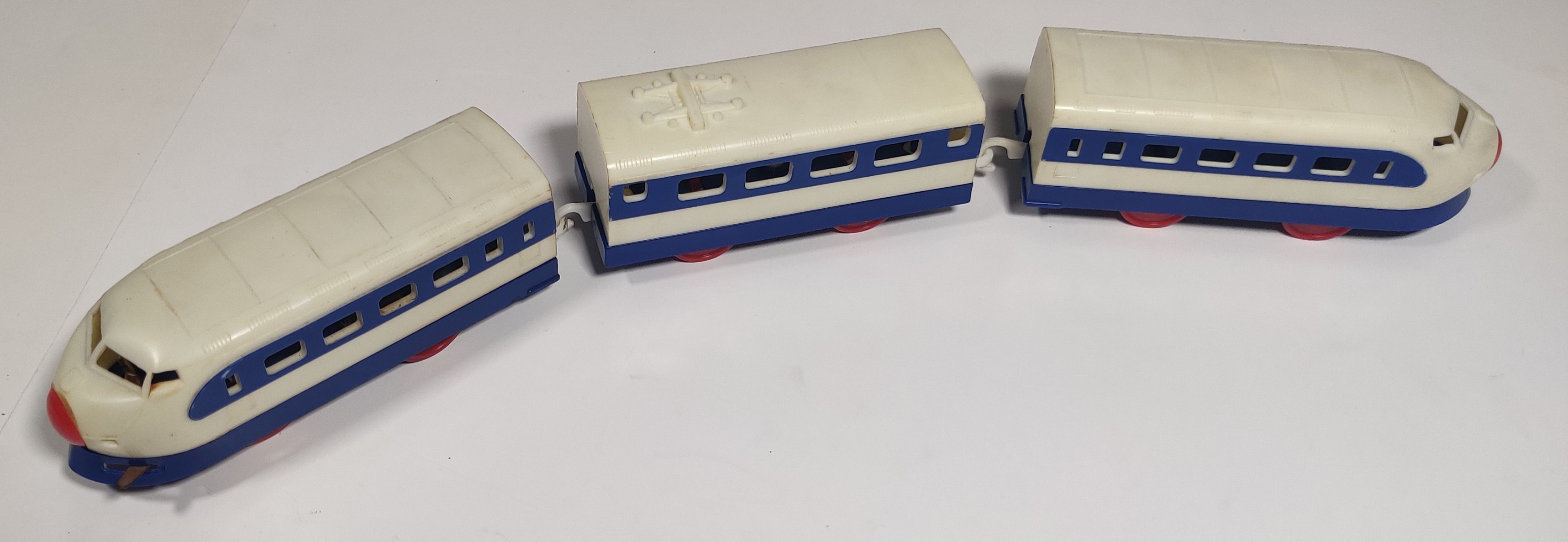
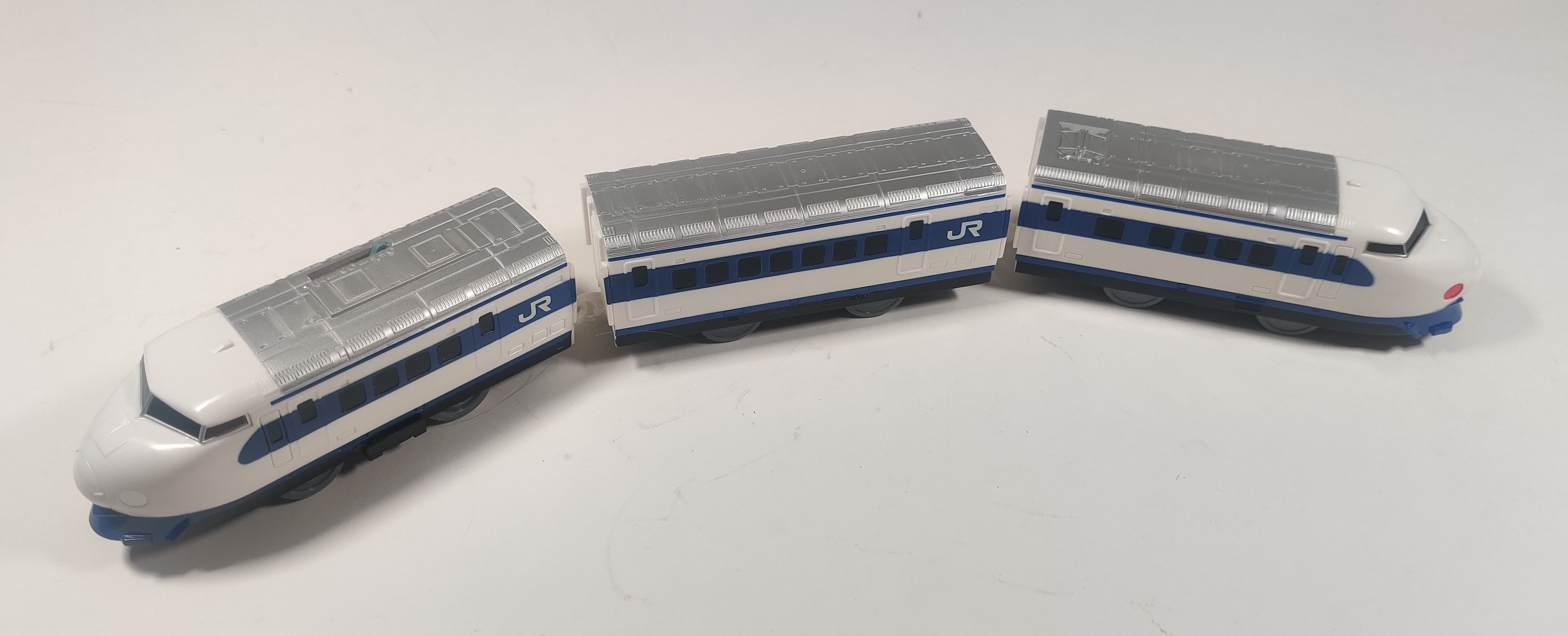
The easiest way to figure out what type of train you have if you have no idea what its name is or what service or railway it runs on is to get an approximate idea of the age (generally, the amount of detail, look and condition, and the "feeling" of the plastic will give you a good idea if it is "old" or "new") and then look on the Plarail Museum for a train that looks right. If your train looks older the sixth generation page has a mix of updated old power and new new power trains while the "modern" look of Plarail was established in the eighth generation. Figure out if you have found the exact release you have or if yours is older or newer based on the gearbox or production markings and use the name of the train provided to look up more about it or search it in conjunction with "Plarail" (プラレール) and see if you can find auction photos that reveal more information about other releases and which one you may have. This section of the Plarail Museum offers a handy reference for when most individual release trains were released and discontinued in different packaging types. If the train has a page on my site it may also contain either a documented example of the revision you are looking at or a description of it.
There are many Plarail pieces that have dates molded into them, but generally they either signify when a tooling was very originally produced or when a license was renewed. Some new toolings from the 2000s were dated with both the year they were new and 1959, the first year of true Plarail production.
Production region
For the first 30 years of Plarail production manufacturing was entirely handled in Japan. Tomy opened their new Thailand factory in 1987 and began producing Plarail there in 1989, with Plarail production split between Thailand and Japan in the early 90s with Plarail production finally moving there completely in 1995 when Tomy closed two of their Japanese factories. Before this point, some export Plarail was produced in different regions (discussed on their respective pages), but any traditional Plarail that is made in Thailand is no older than 1989 at the earliest.
Some export Plarail was manufactured by Tomy in Hong Kong and Taiwan. In the late 1990s and into the 2000s some Japanese-market Plarail was manufactured in China, particularly some Motor Tomica-related sets as production of Motor Tomica largely moved to China in 1996. Starting around 2010 and accelerating in the 2010s Tomy began producing more Plarail in Vietnam, with current Plarail products being a mix of Thailand and Vietnam manufacturing.
Production features
Although almost all Plarail from every era is largely cross-compatible, some "standards" like the coupling system and undercarriage designs have been improved over time and new gearboxes have been introduced. Based on what kind of drive system, design of wheels, or other features a train has, a range of probable production can be found.
Early Plarail rail is all smooth with no intentional surface inside the rail troughs. As the vast majority of trains became motorized in the 1970s most rails were updated to a roughtop surface. With the move to direct drive "new power" gearboxes in the late 1980s most track was updated again to have a consistent treaded pattern, sometimes over existing roughtop treaded toolings and sometimes fresh. More details can be seen on the pages for particular rails in the rail section.
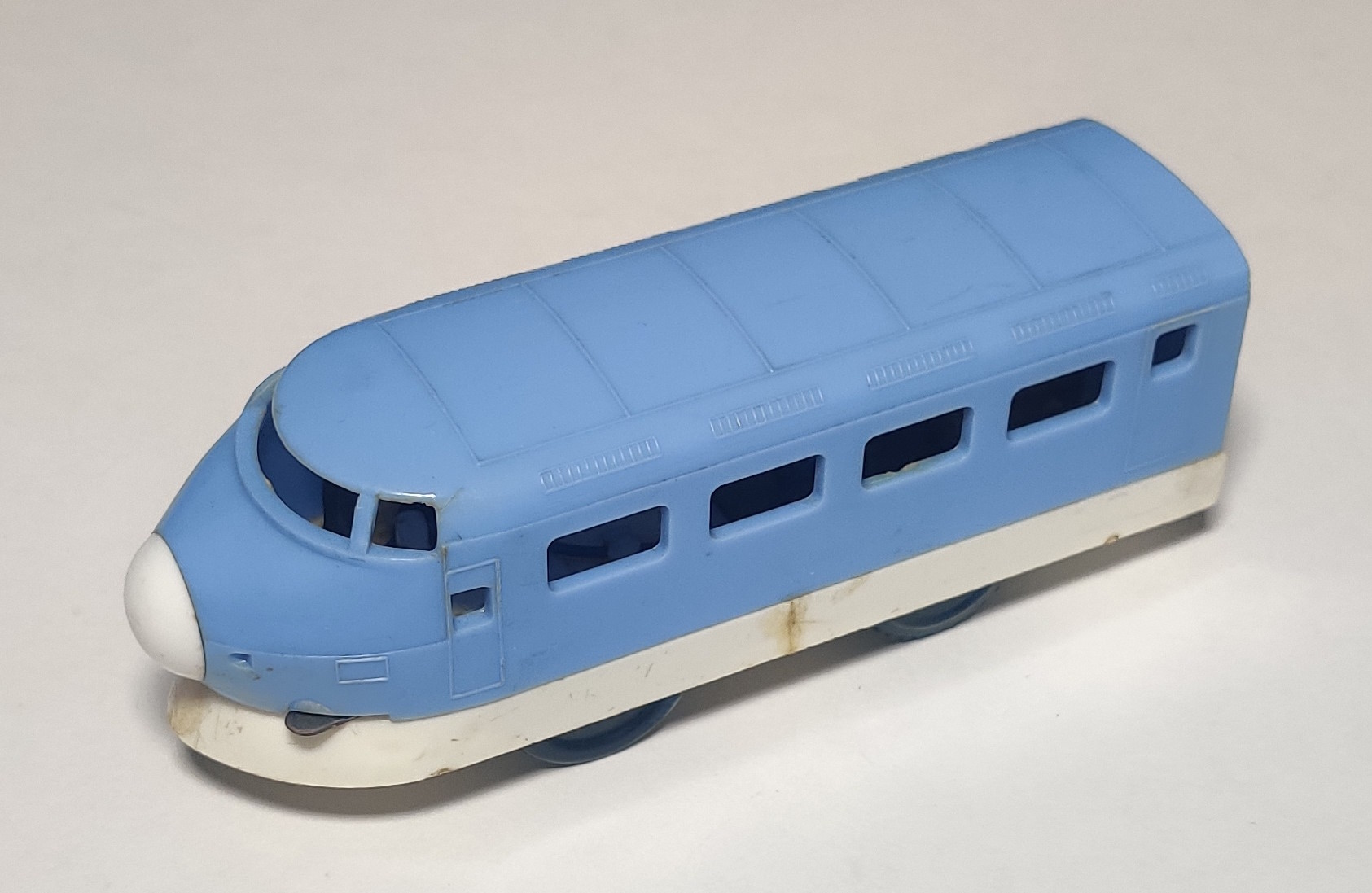
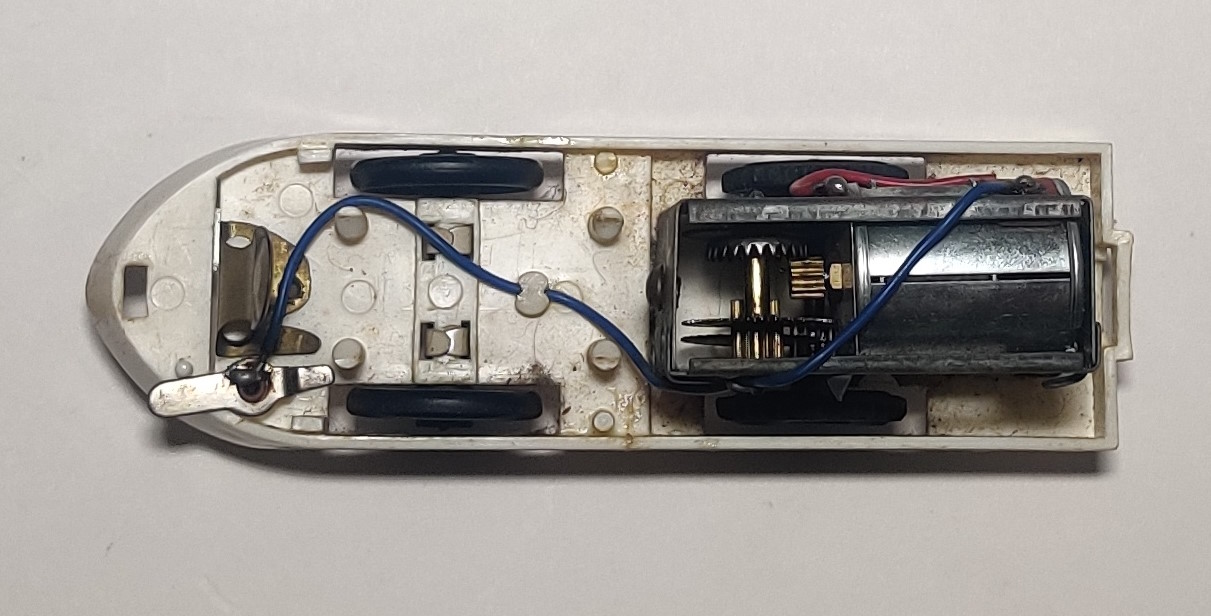
Early Plarail gearboxes are all metal. The very original gearbox used in the Electric Plastic Train, Highway Bus, and the version in the original Electric Super Express Hikari and the export Child Guidance version shown here has the power switch mounted to the chassis and coming out of a slot in the body shell and is direct-drive. Drive wheel traction tires were black and thinner with thinner wheels overall in this era.

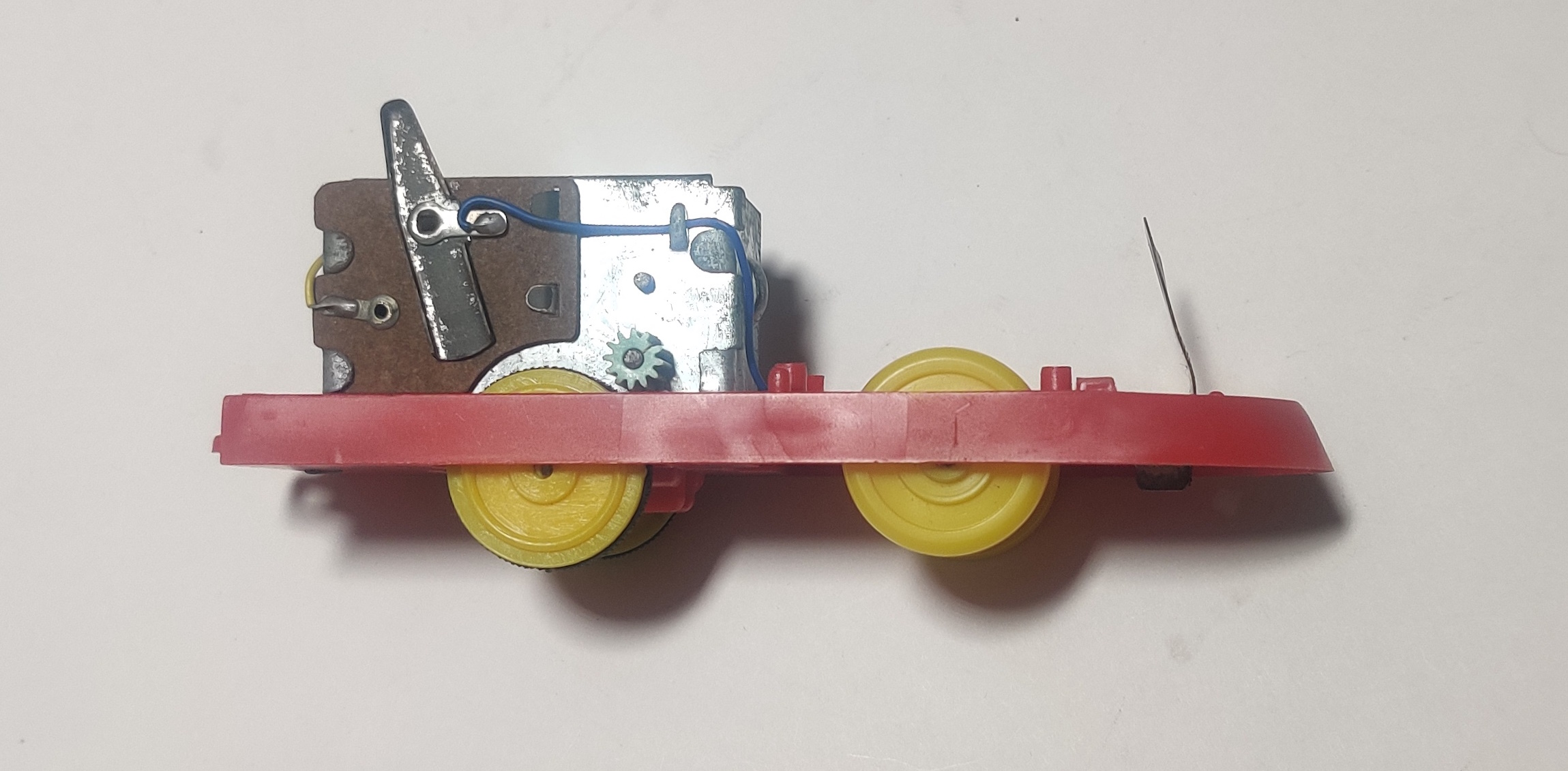
"Second generation" gearboxes are also all metal and use a roof power switch design, although they are friction drive and the switches do not disengage any portion of the gearbox like the later direct-drive new power gearboxes. They also use plastic gears to transmit power to the drive wheels.
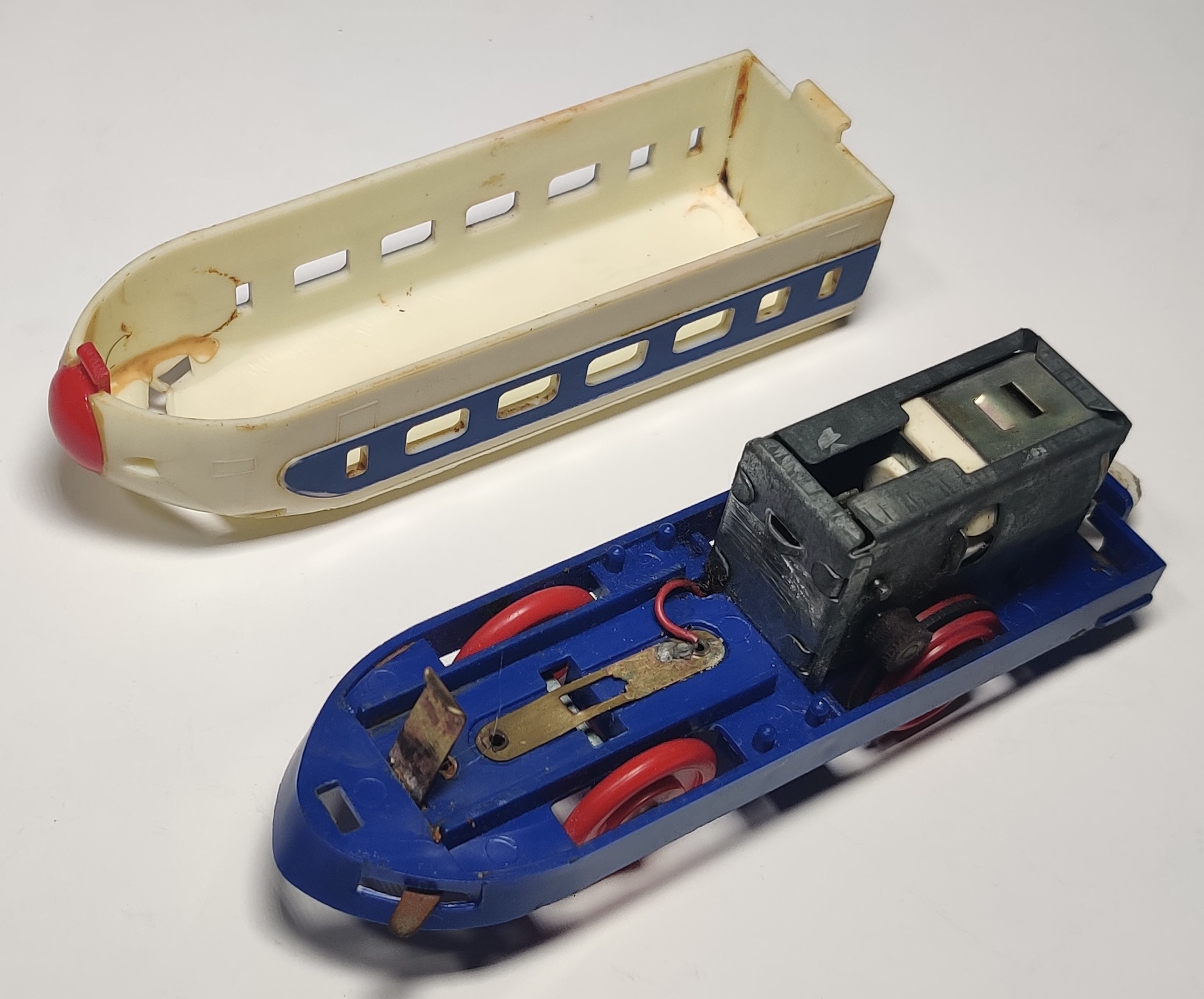
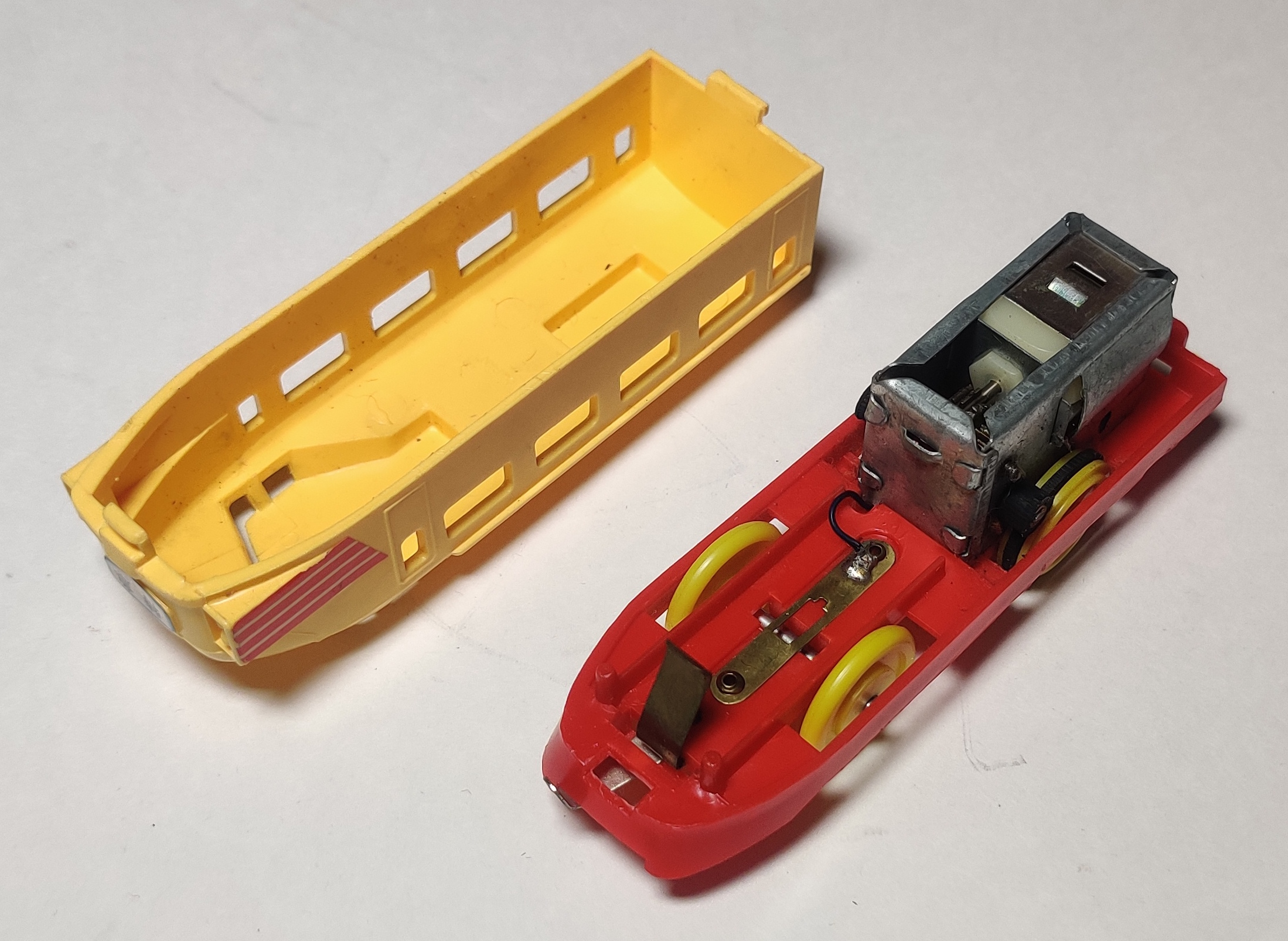
The next gearbox, introduced in 1969 and put into great use starting in 1970, would power the majority of Plarail trains throughout the 1970s. Very early examples still use plastic gears, but most earlier 1970s versions use a darker rubber drive drum compared with the later 70s and 1980s rubber tires. Brass contact strips were used on all Japanese-made Plarail like every other made-in-Japan Tomy toy I can think of - when production of Plarail and other toys moved to Thailand in the 1990s these changed to a silvery nickel-plated steel.
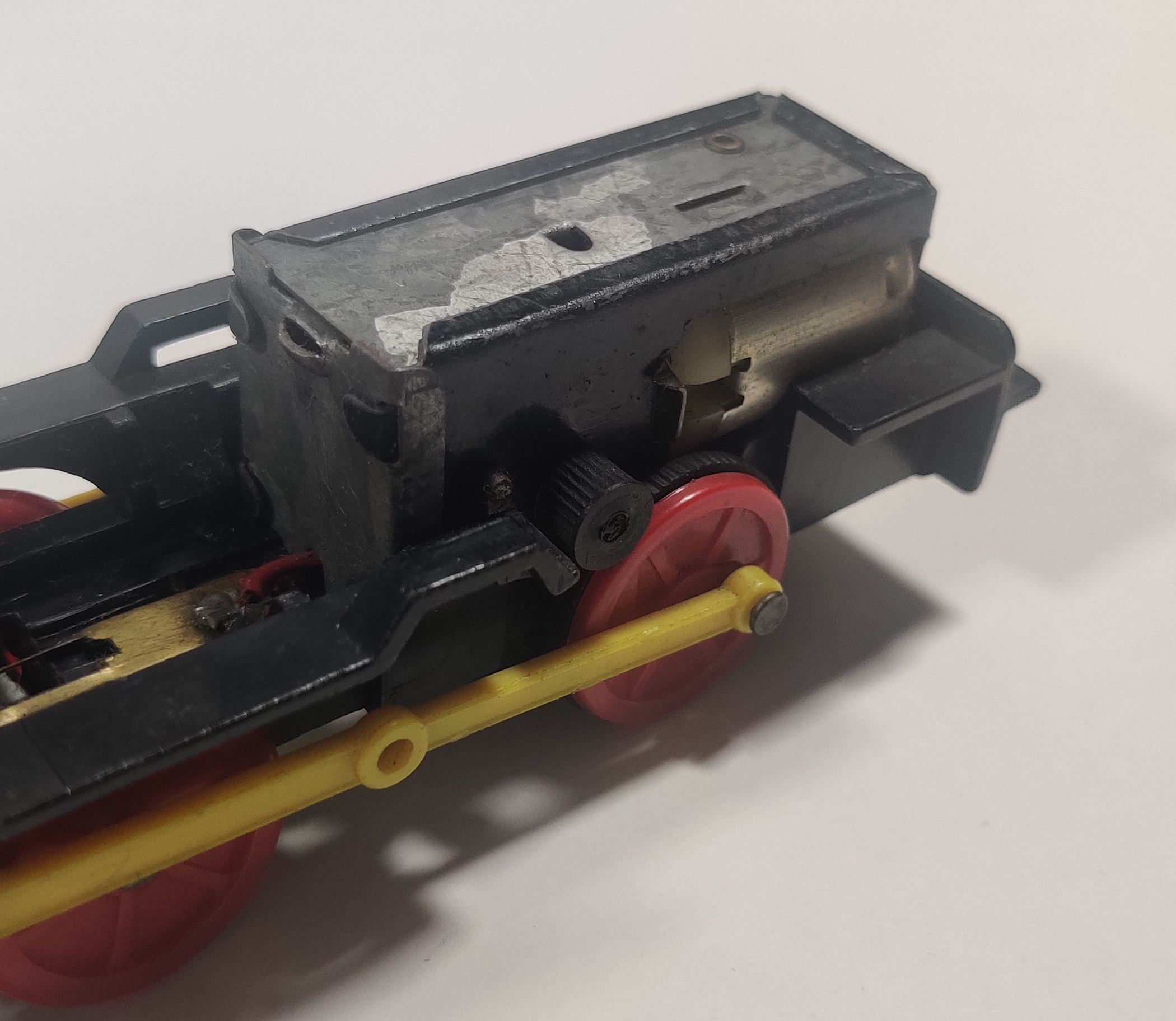

A larger version with clicking "chuffing" noisemaker was used for steam locomotives and was even be put into Thailand-made engines before the last D-51 and C-12s to use them were finally converted to new power in the mid 1990s.
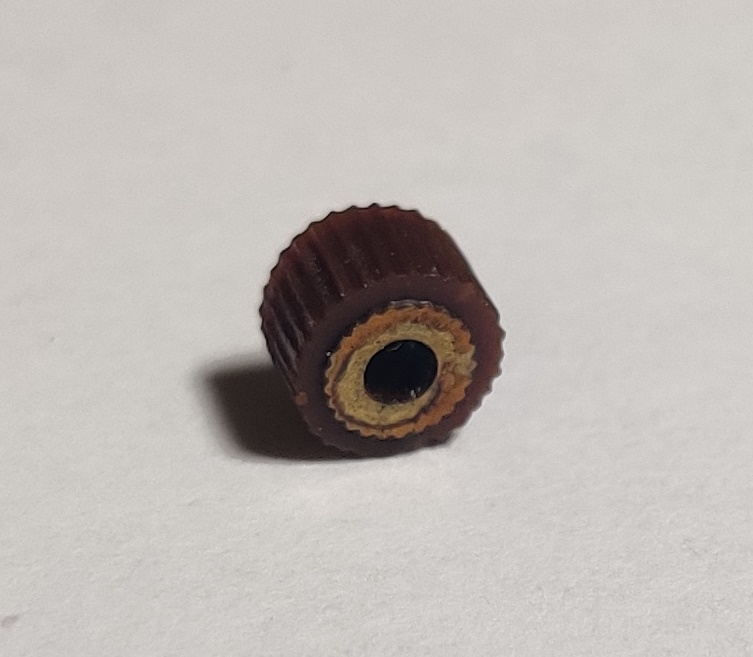
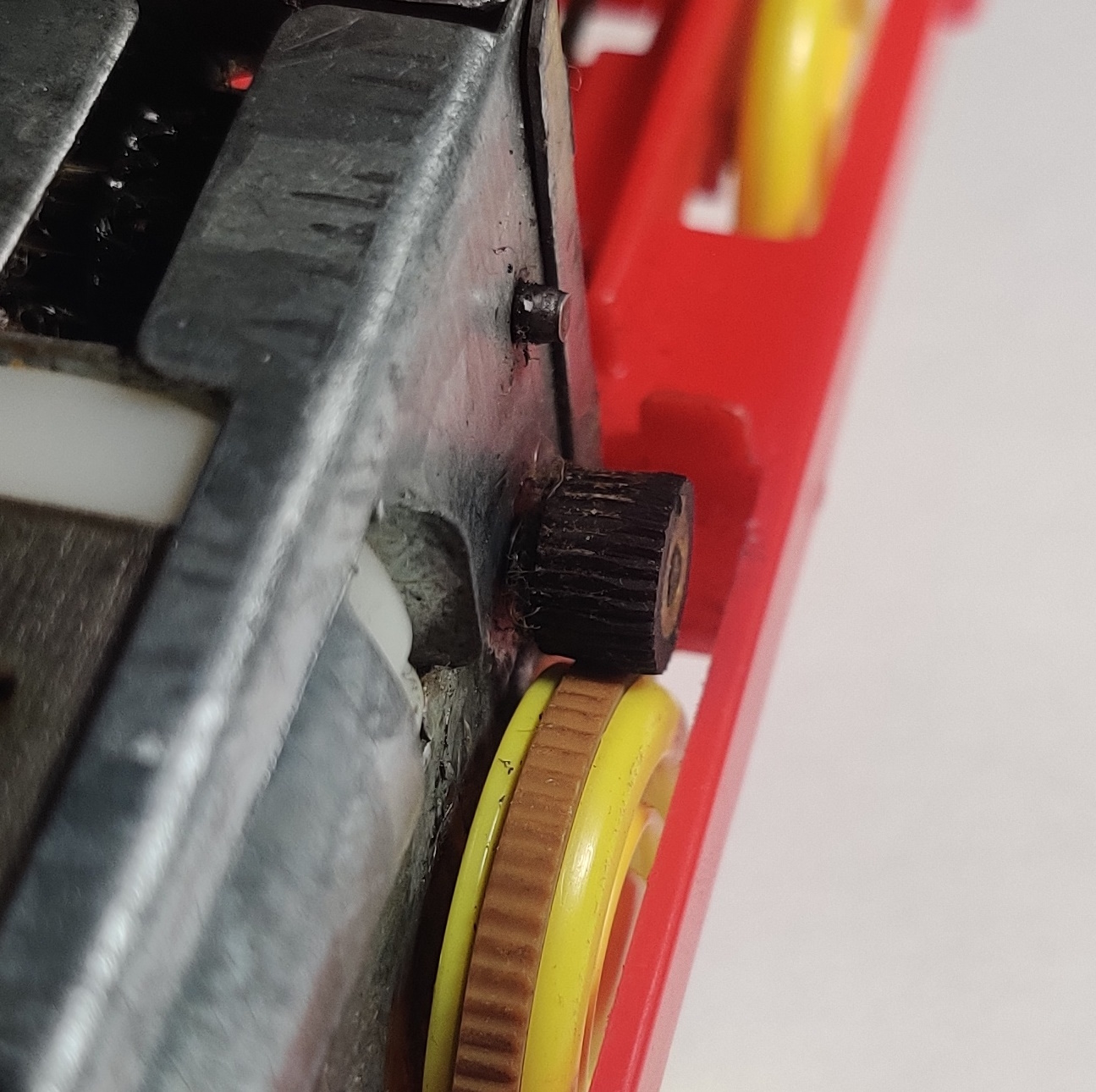
Traction tires changed to the more modern type with the move to the matching friction-drive tires.
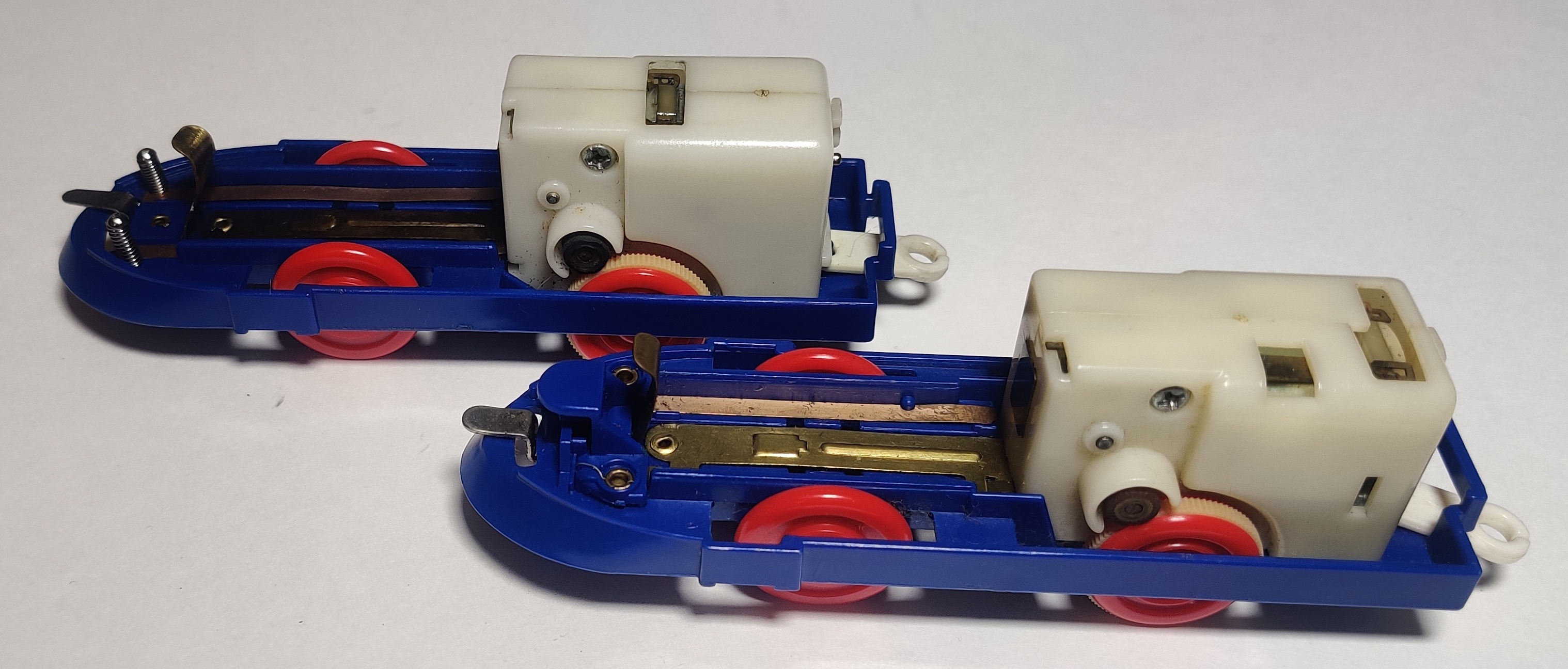
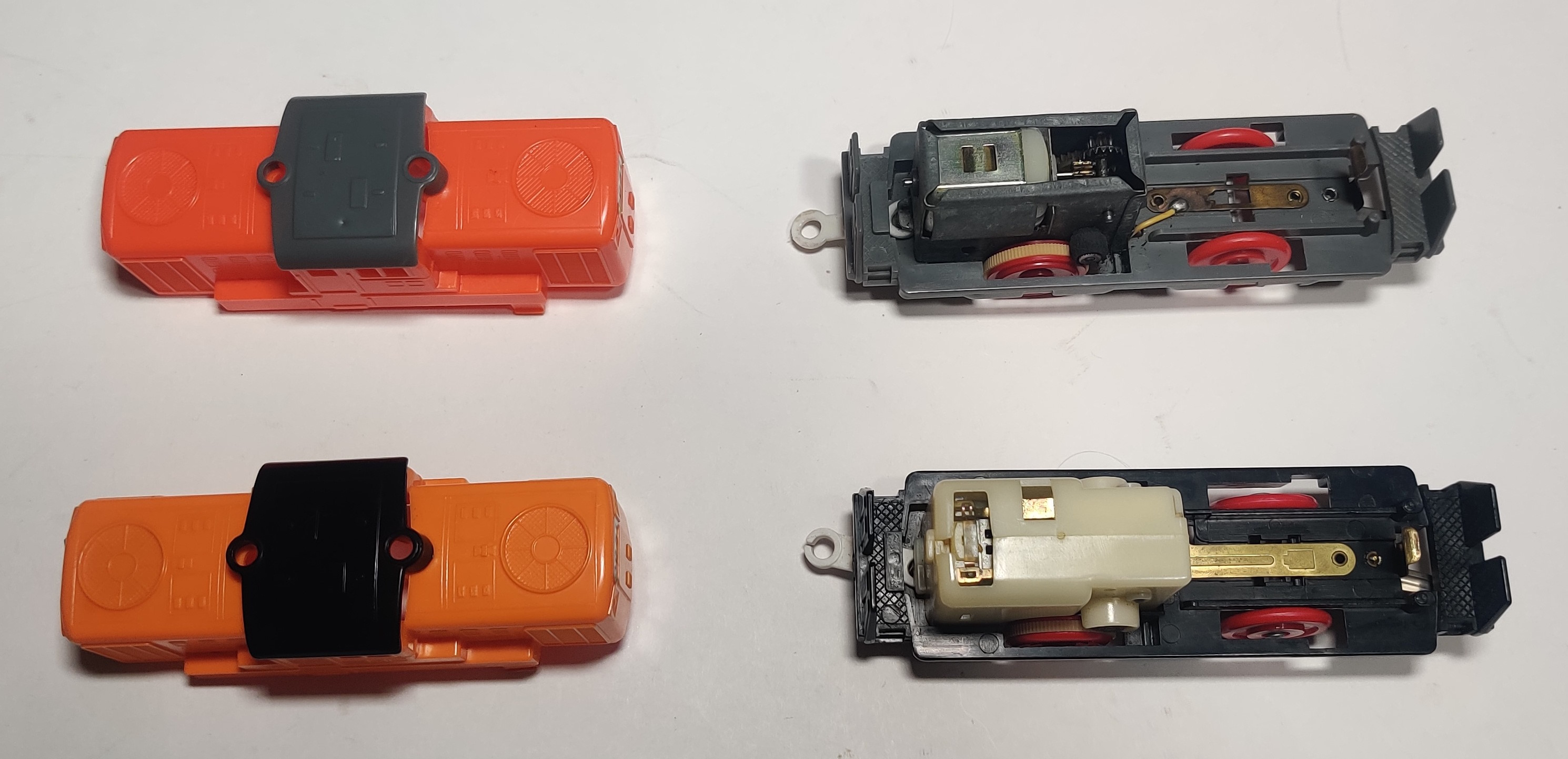
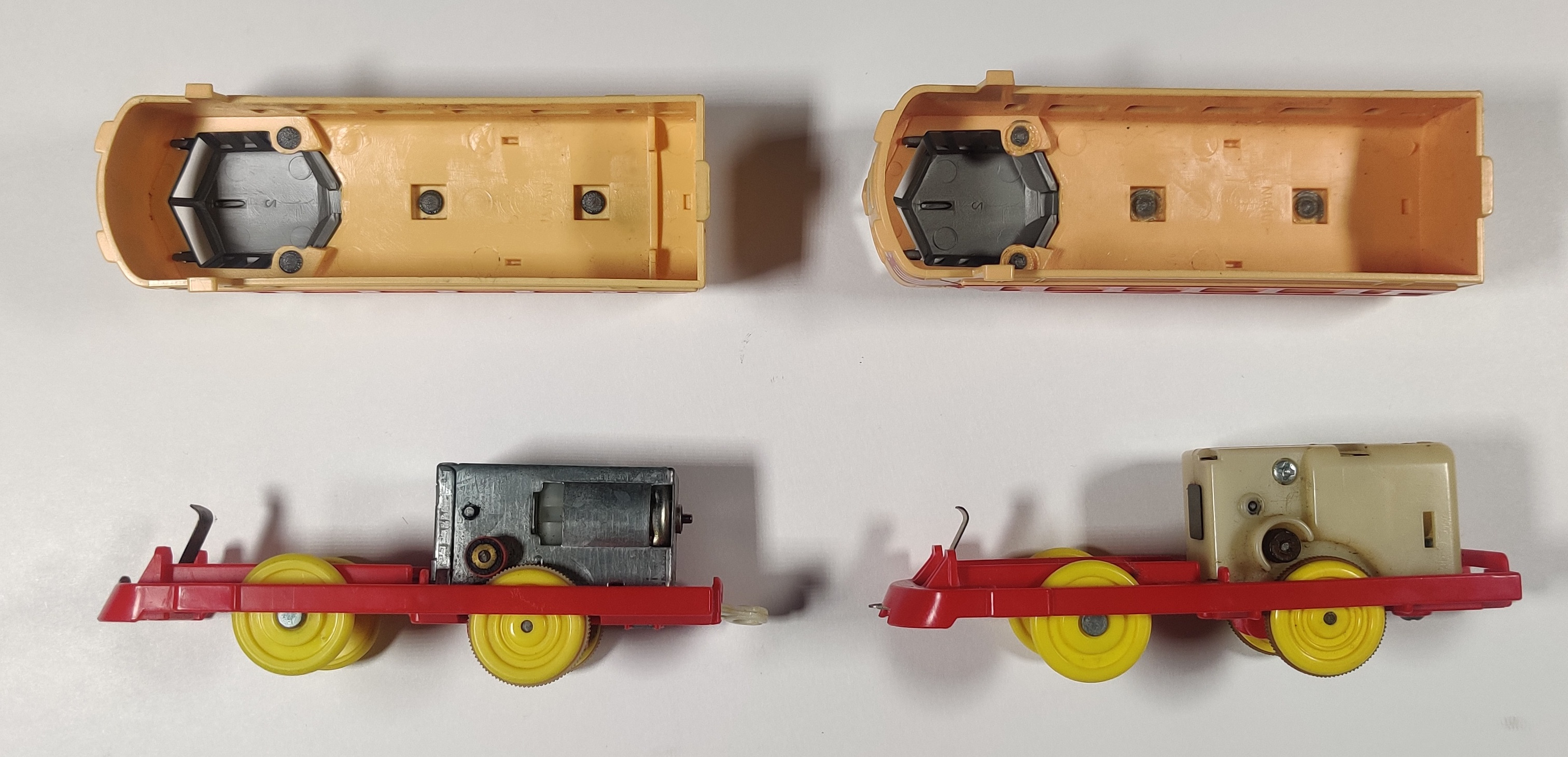
In the later 1970s a plastic friction-drive gearbox was developed. Many 70s metal-gearbox trains were updated and converted to use the plastic gearboxes if they fit. These gearboxes powered most pre-1987 1980s Plarail trains. A few variations of the tooling exist for different motor configurations.
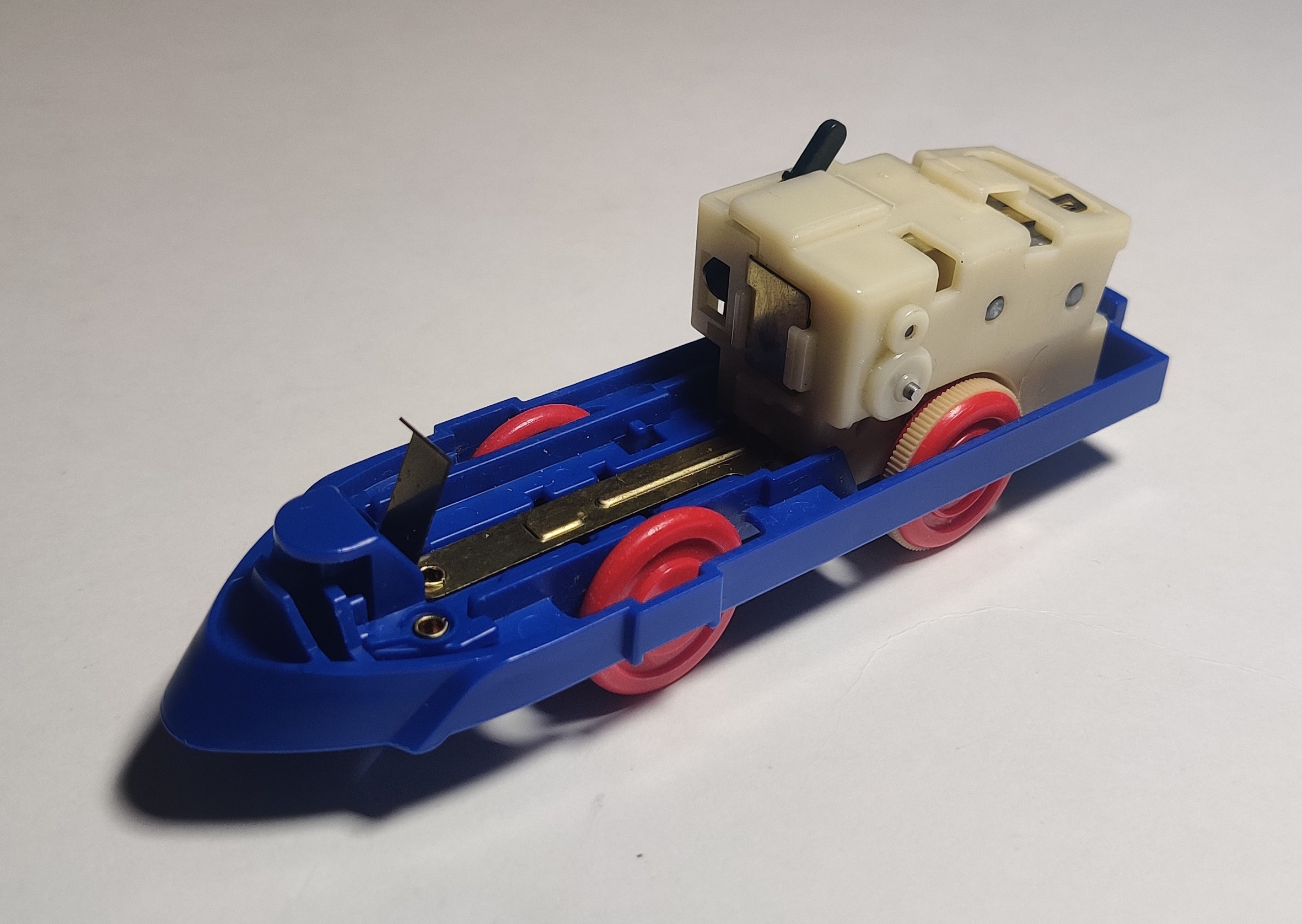
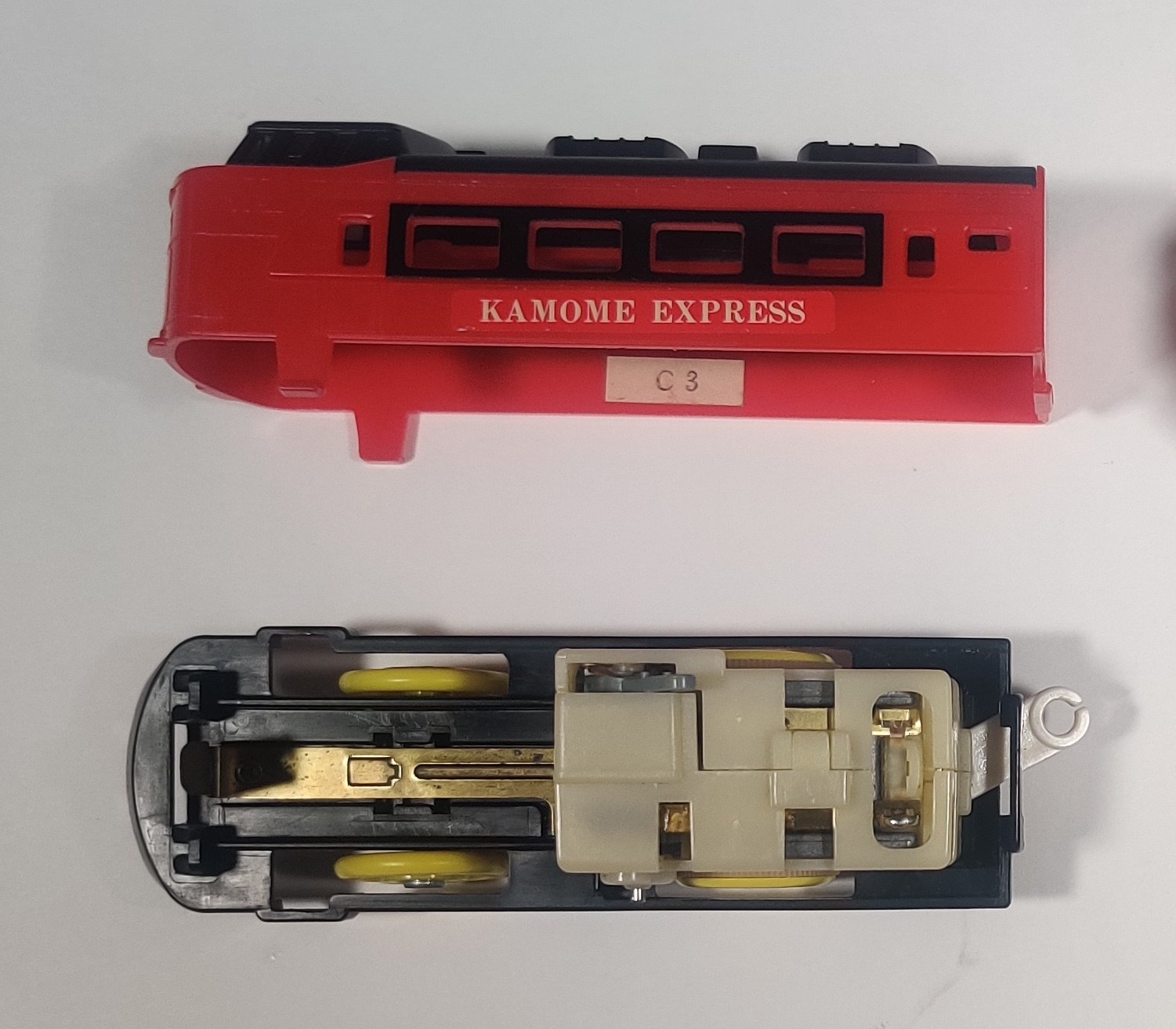
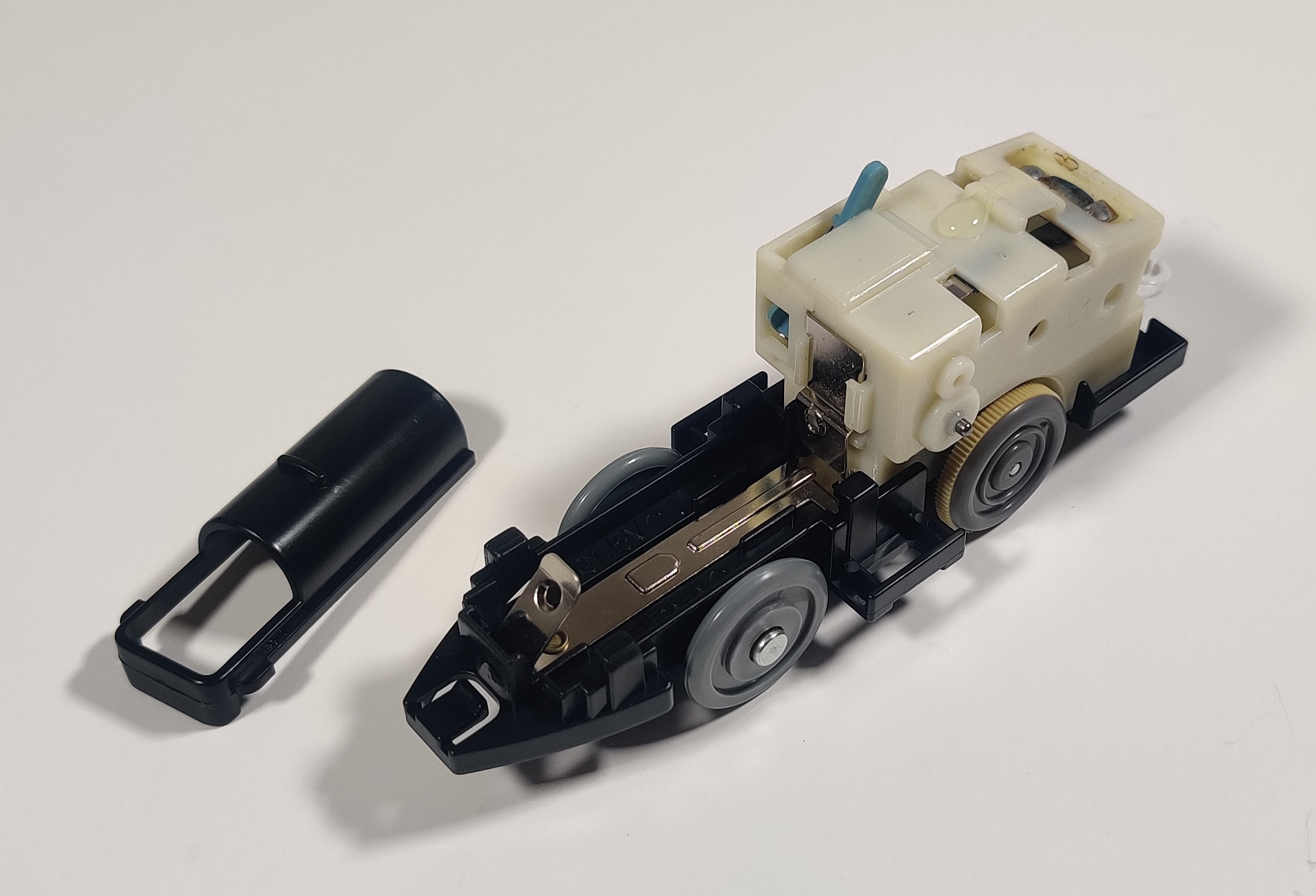

In 1987 Plarail tractive power was forever changed with the introduction of the "new power" gearbox. The new power gearbox was direct-drive and produced in both single and two-speed versions. Like other gearboxes, earlier Japanese production types had brass contacts while Thailand ones had silver. Different color switches were used for the two-speed version at various points - briefly black on original 2-Speed Shinkansens, then a greyish-blue for most Japanese production, then lighter blue in Thailand into the 2000s. Single-speed gearboxes also used a bluish-grey switch during Japanese production but were all white starting with Thailand production. Nickel-plated battery contacts can be seen in the AA-style Shinkansen chassis above.
The Plarail coupling system has also changed several times, particularly in the earlier days. Here are some notes about dating by coupling styles - keep in mind that couplers are sometimes broken and replaced so a used train may or may not have its original set of couplers (it probably does, but if one coupling on a train is different from the others this may be a sign of a parent (or some other collector) replacing it at some point). Occasionally, it is found that for whatever reason an out-of-season coupling style has been used later in production - some trains and even Tomica World exports used the single-split rear couplings. An intact three-piece train with matching couplers from the same source probably has its originals and, combined with the other traits noted here, can be a factor in dating a train.
| Coupling style | Era | Notes |
|---|---|---|
| Metal hooks | 1959-1966 | Early push trains as well as electric trains used metal hook style couplings that could interlock |
| Plastic "straight through" style | later 1960s (push trains) | Later push trains changed to using a single-piece coupler that ran the length of the car and had a loop on one end and a hook on the other |
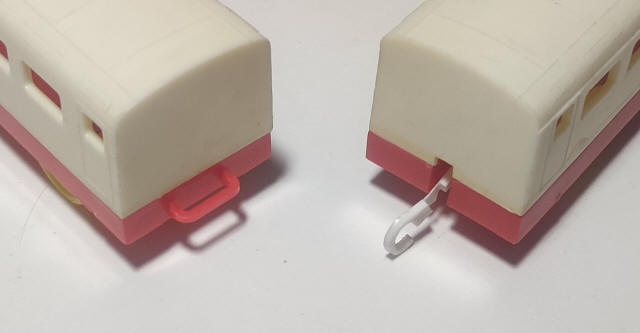 |
1966-1969 | Used on later 1960s electric trains, plastic bars molded into the rear of cars and a hook coupler that is similar to the modern type but with a thin flexible section. A similar style of coupling was used on Freerail, also by Tomy. Fragile, and the cars they are included in are often glued shut and hard to open without further damage |
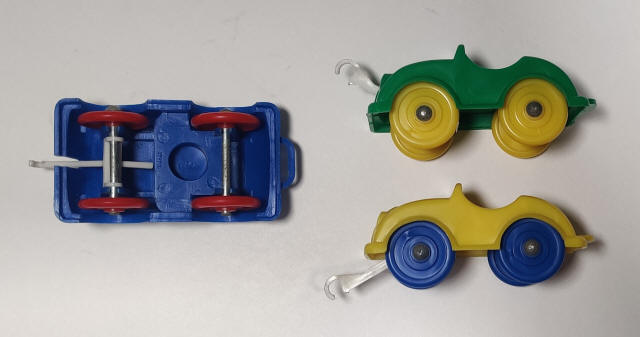 |
1968-1969 | Amusement Park series couplings |
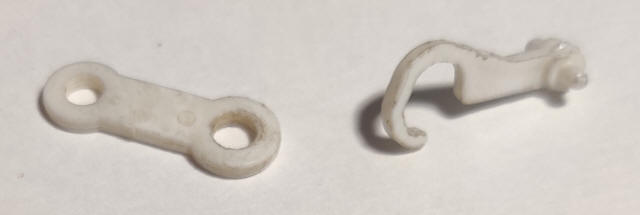 |
1969-1975 | Chunky squared-off earlier 1970s couplings, the rear loop style has no slit and the "hook" is more open |
 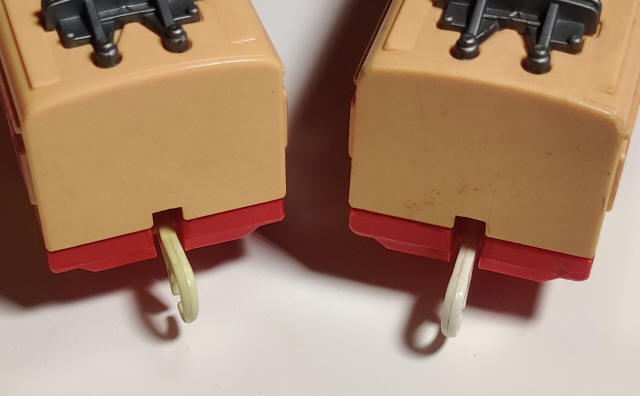 |
1975-1977 1978-1979* 1980-1990s |
These couplings already resemble
the modern type that truly clip together. The rear coupler has a
single split in coupling hole with no added strain relief. Began
being replaced in the early 1990s but then used with
seemingly little rhyme or reason on later 1990s Japanese
releases, Tomica World exports, and seemingly occasionally into
the 2000s *For whatever reason, couplers from around this period yellow more intensely and more often than the period before or after |
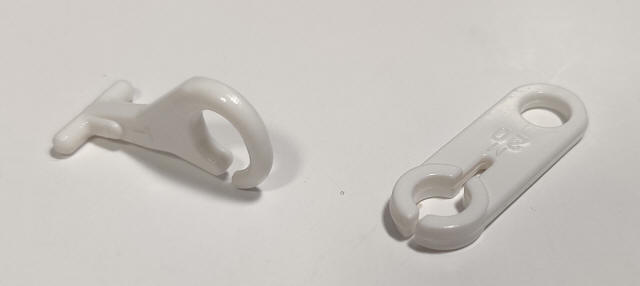 |
1992- | The "modern" style of hook and loop couplings |
Production stickers/marks
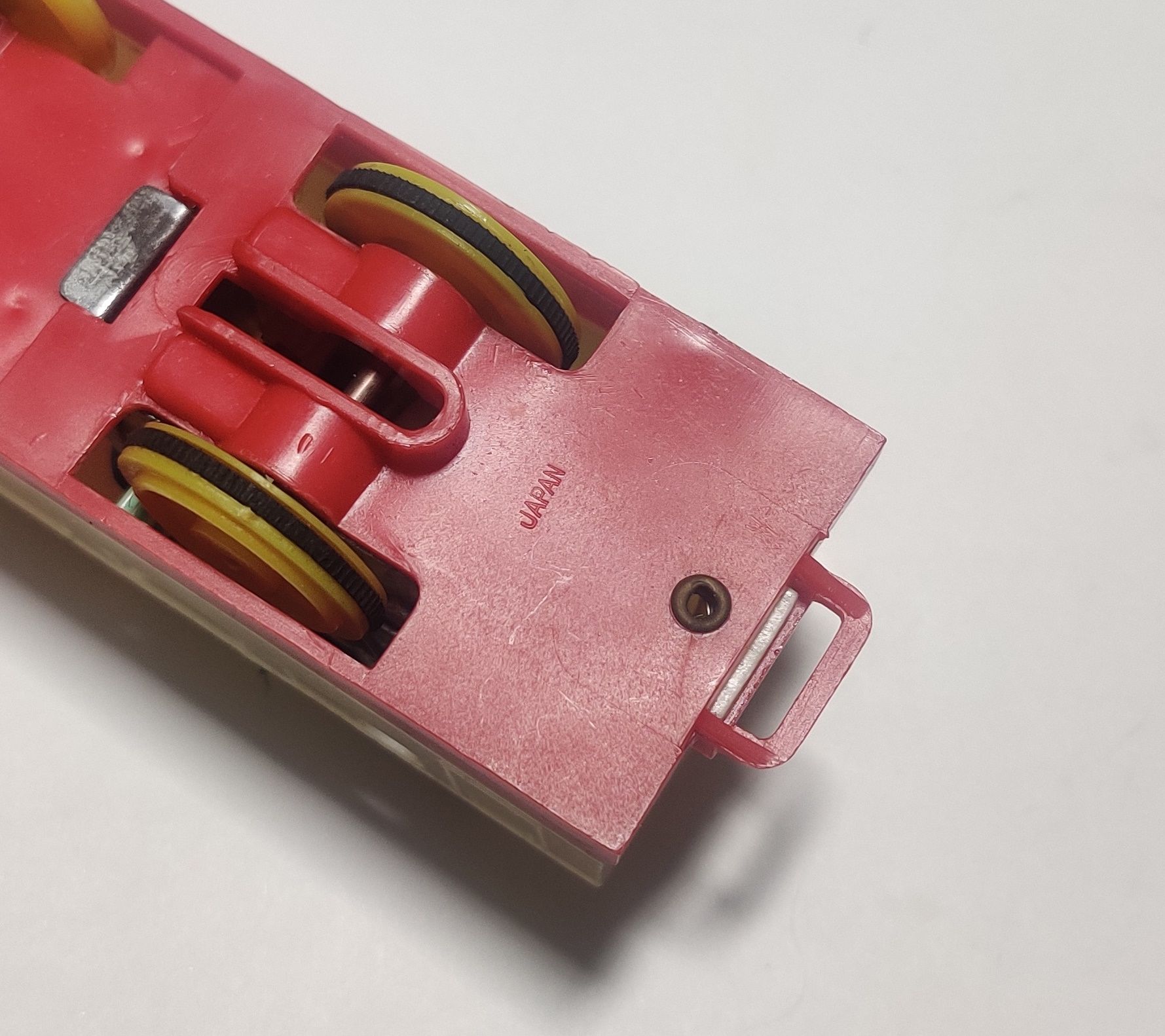
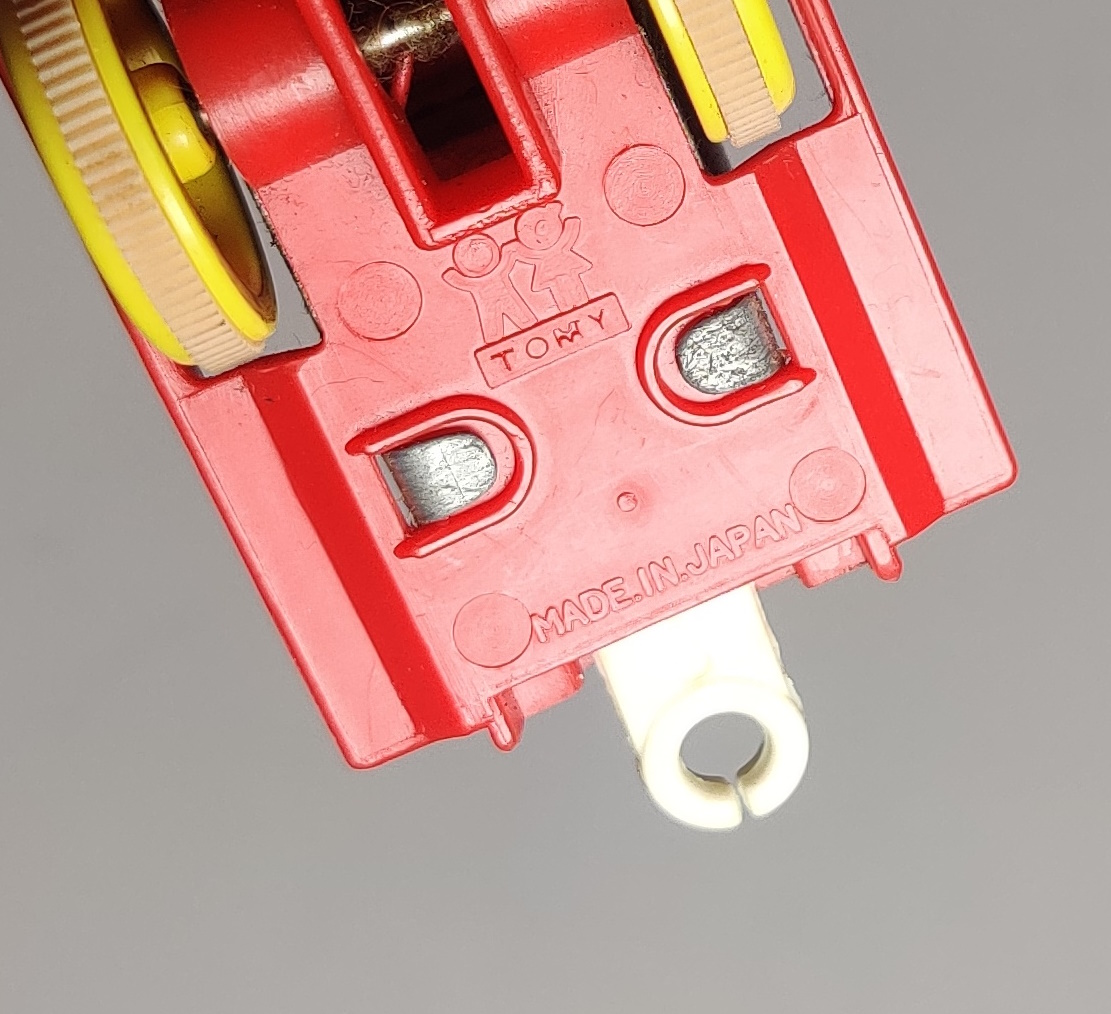
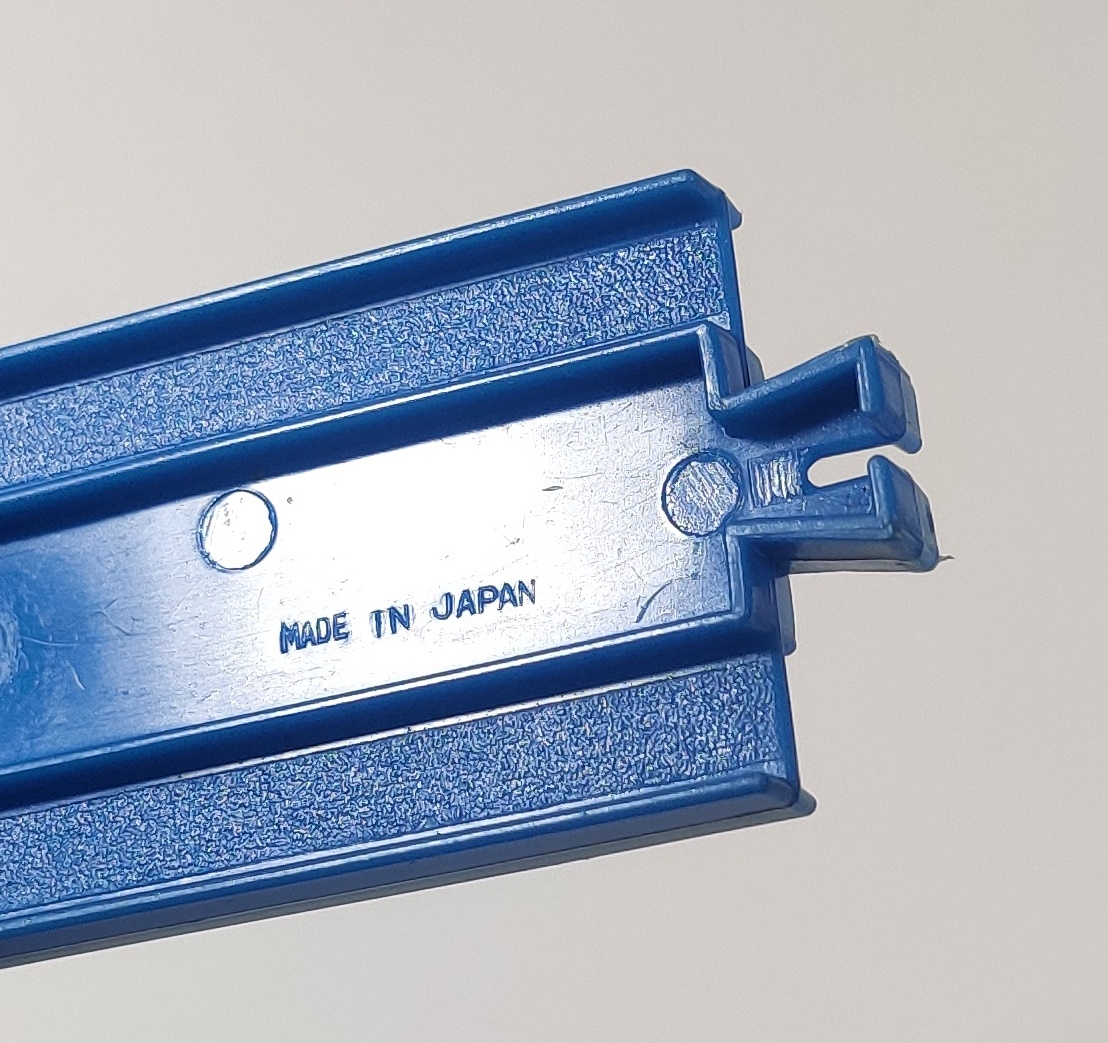
Very early examples of accessories from the 1960s to the mid 70s were sometimes not marked with Japan text in the tooling but most track, accessory, and train components were marked with JAPAN marks by the later 1970s.
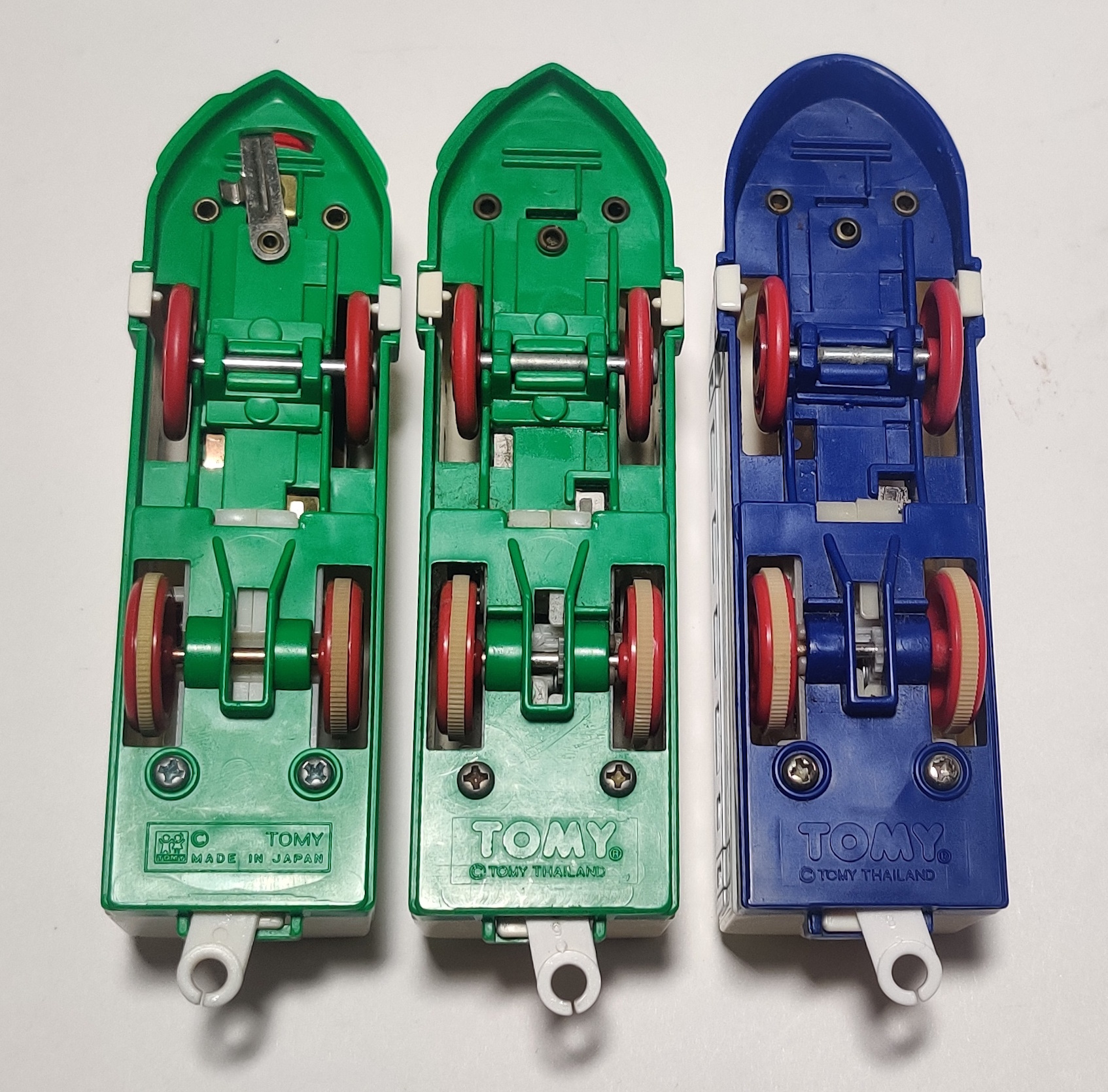
As production moved to Thailand in the 1990s, many older toolings were updated. Many older trains have old power Japanese production, new power Japanese production, and new power Thailand production variations that are overall fairly similar.
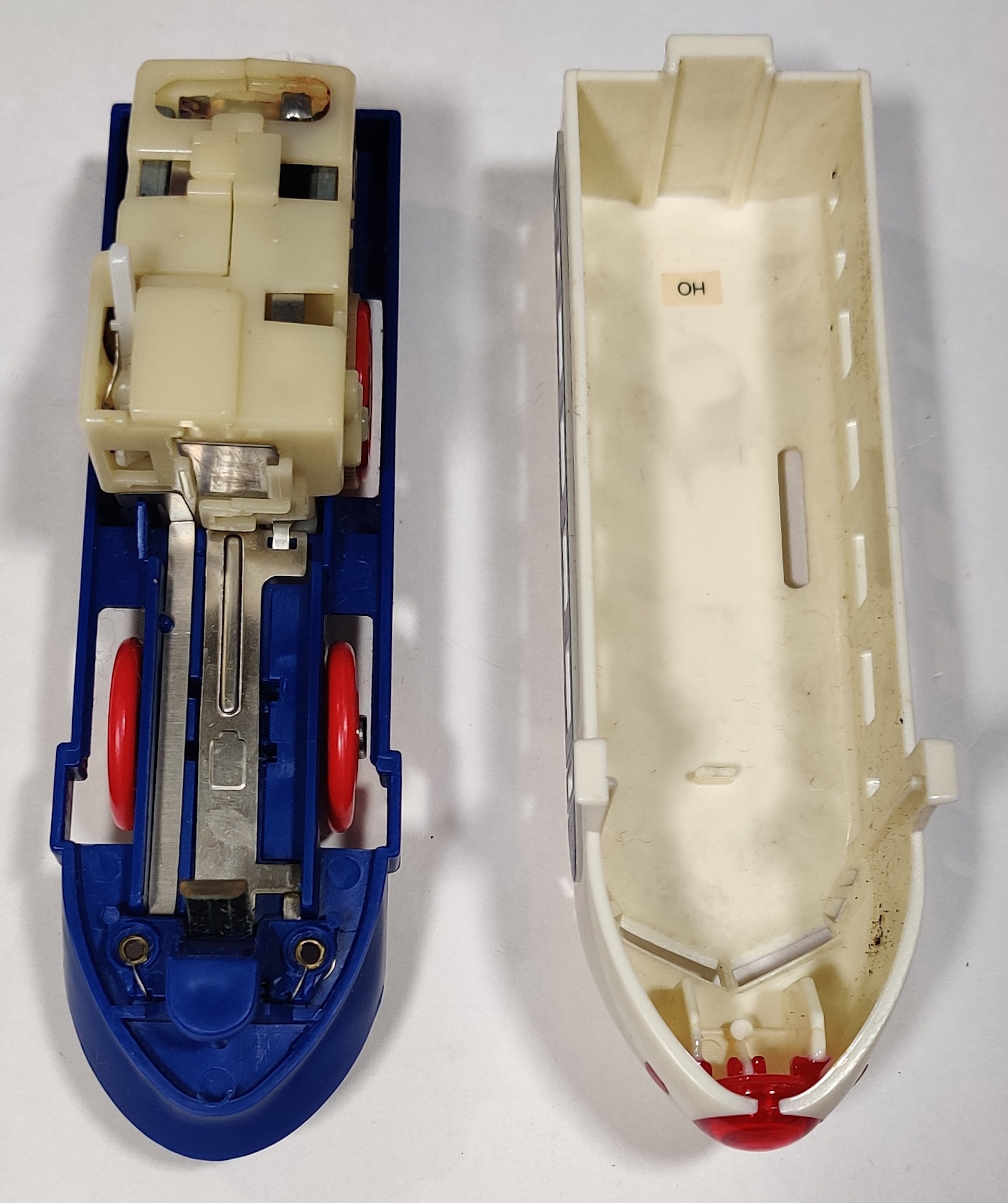

Since 1990 Plarail power cars and some battery-powered accessories have been marked with a period of manufacture, originally with a sticker and later sometimes stamped into part of the plastic molding. The original sticker types included a letter A to L corresponding to the month of the year January to December and a number signifying the last digit(s) of the year. Later, plastic-stamped codes also included a day of the month before the last two digits of the year.
Sticker date codes can fall off (or are sometimes located on battery compartment covers which are lost). Any Thailand-made locomotive after 1991 or so should have originally had a production sticker of some kind, but many lose them over time. Nearly all Japan-made trains will not have a sticker, but late-to-move old and new power trains like the DD51 and 485-series L Limited tooling in the Kamome Express livery were still produced in Japan into the early-mid 1990s.
In the 2000s some toolings began to be produced with the date stamped into the plastic itself, appearing occasionally inside on the roof of the power car like stickers but more often on the bottom of the chassis. Some components like gearboxes also began being marked with the specific day of manufacture in the later 2000s, when the plastic-stamped markings were also specified down to the date.
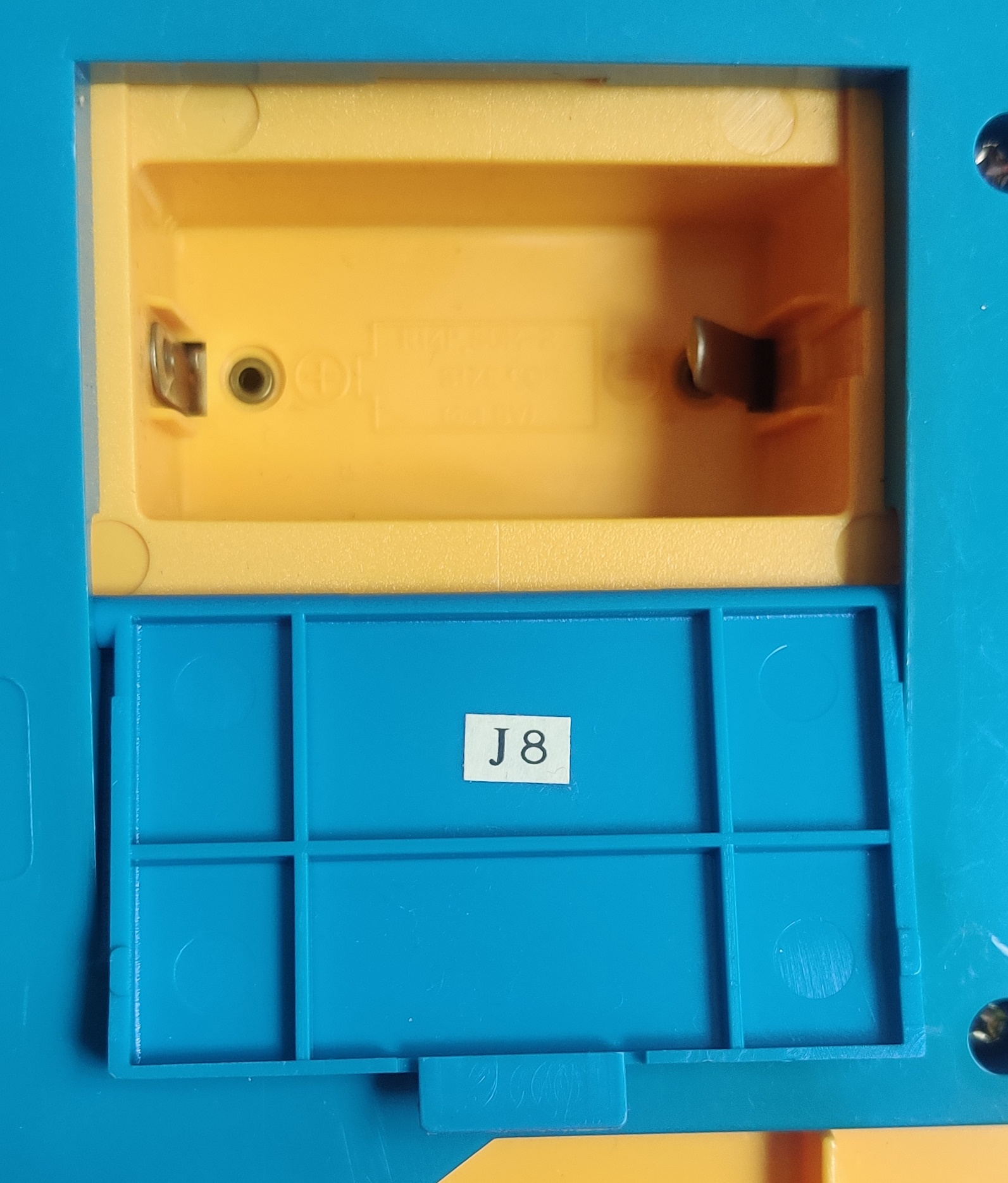
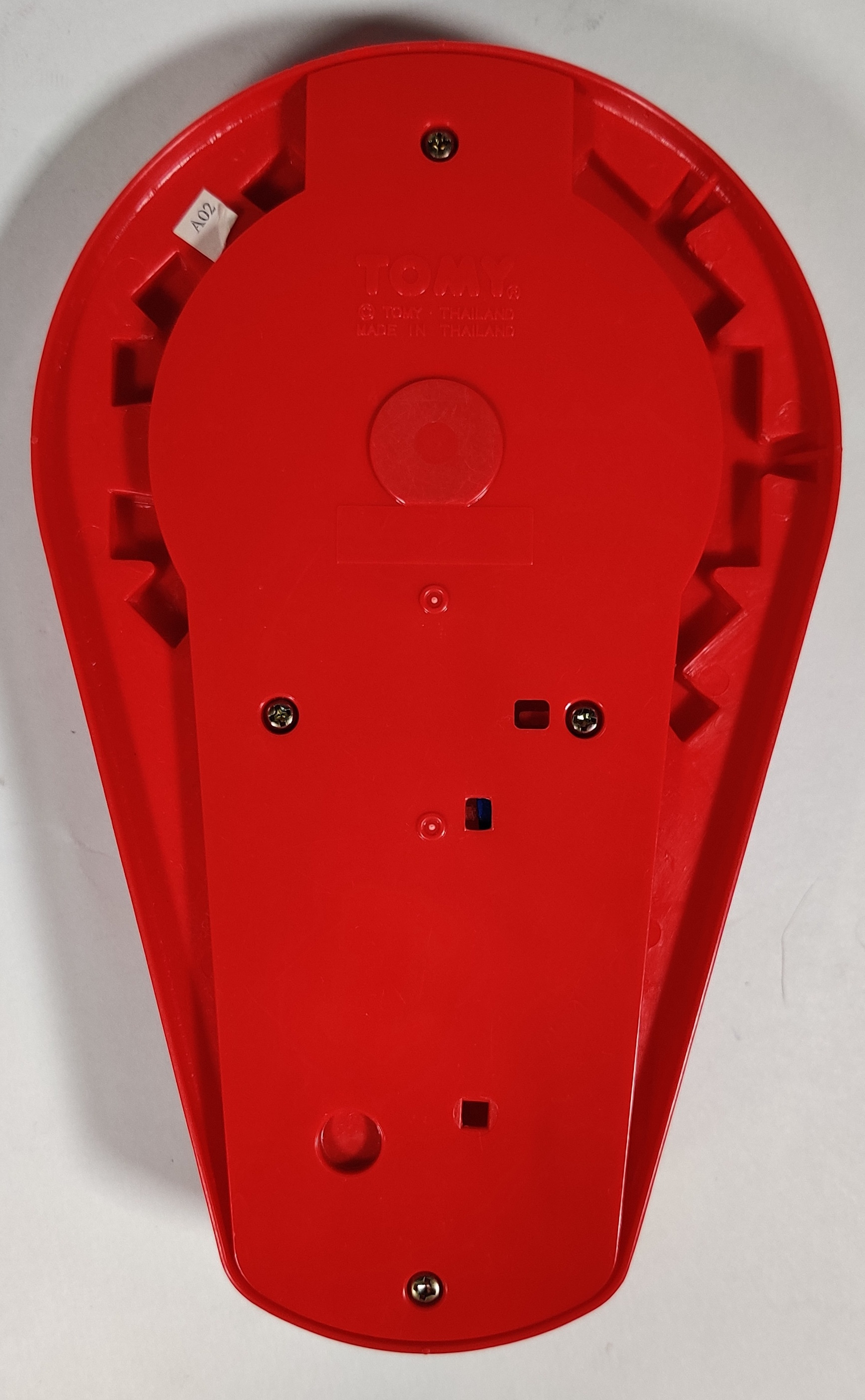
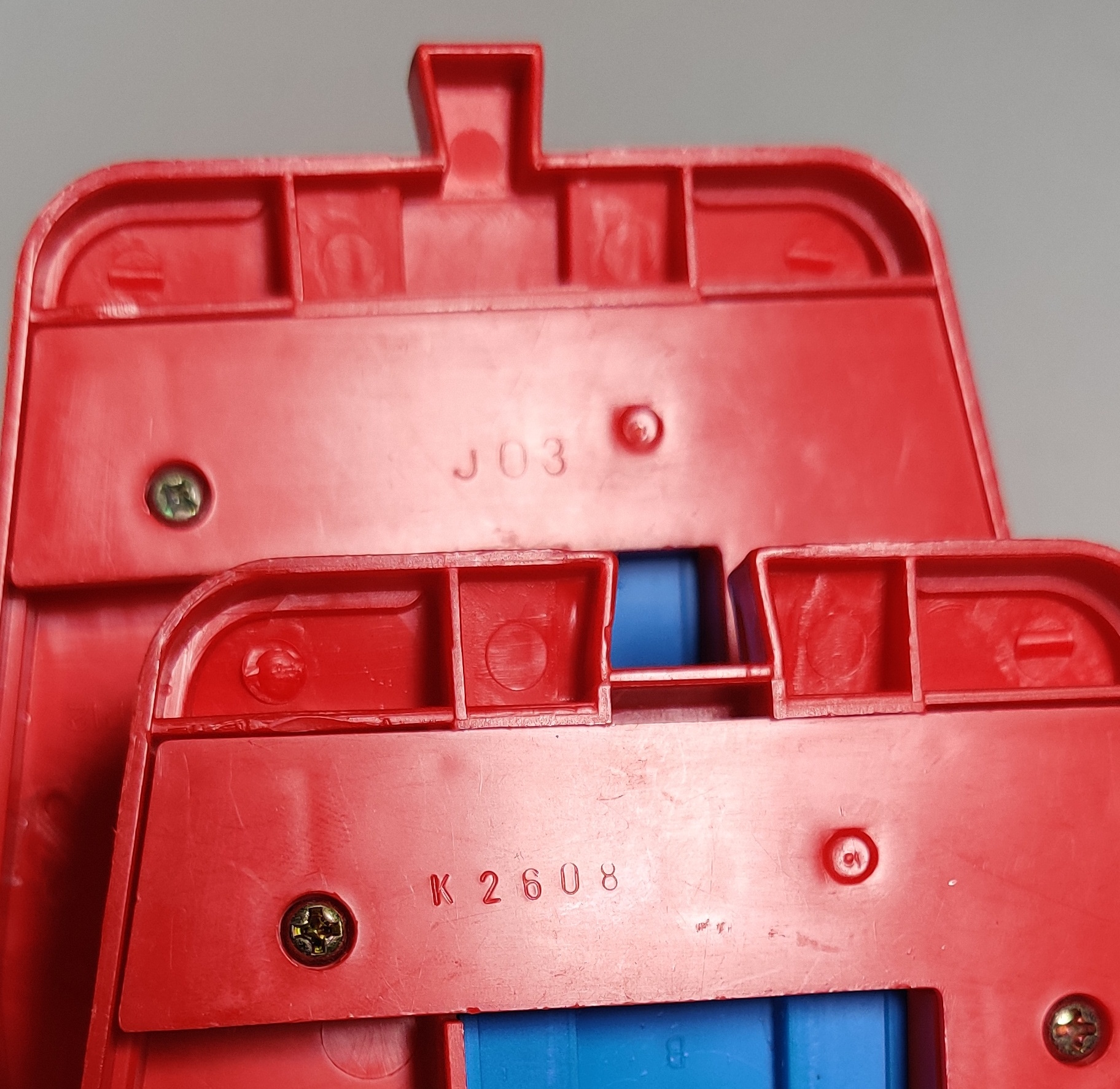
Since the later 1990s many battery-powered accessories have also been marked with similar stickers in their battery compartments. Beginning in the early 2000s, many individual and larger accessories were marked with their production period, first with stickers like trains of the era and later with production marks in the plastic itself. Like trains, later on this code expanded to include the day of the month it was produced between the letter representing the month and the last digits that signify the year.
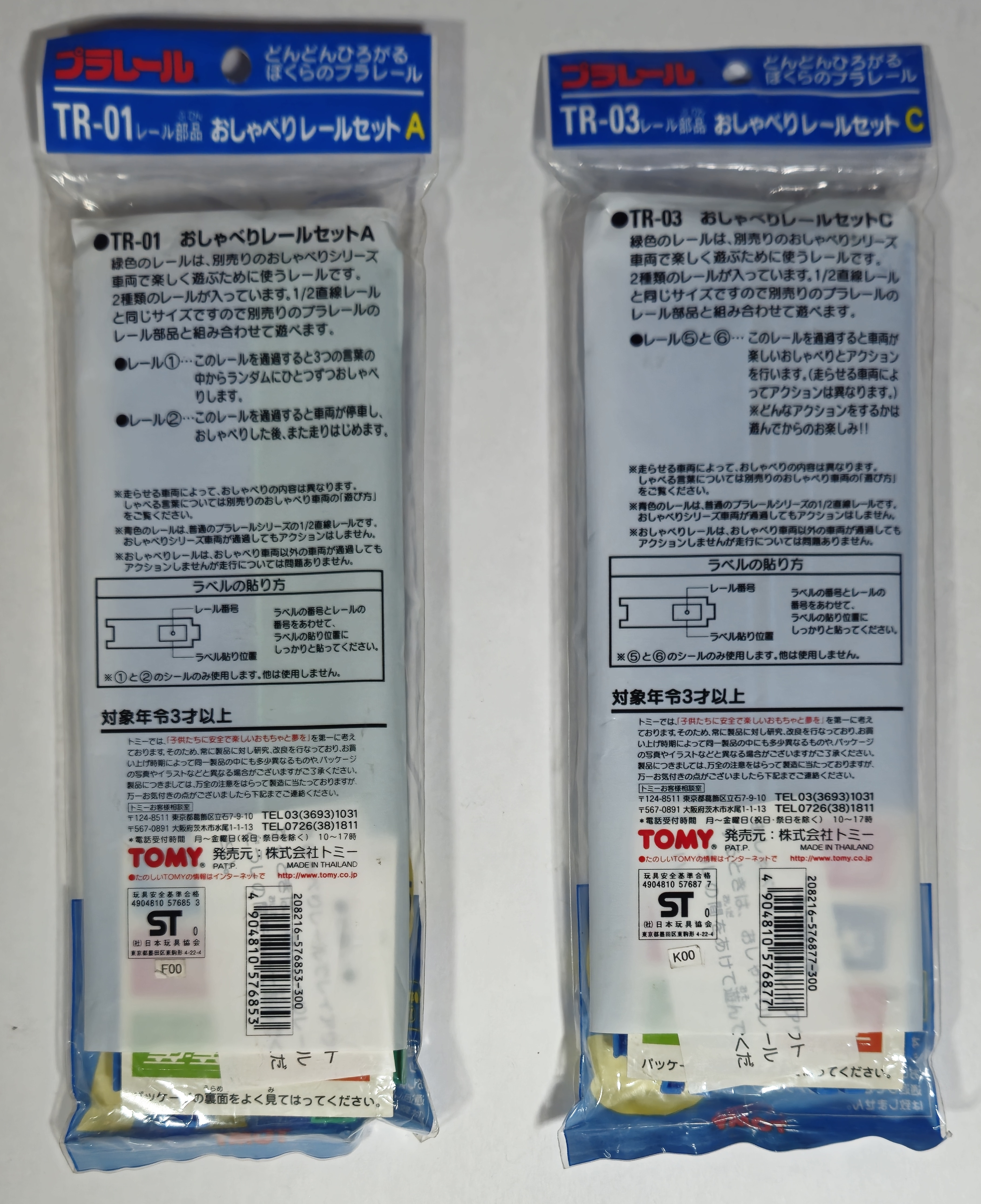
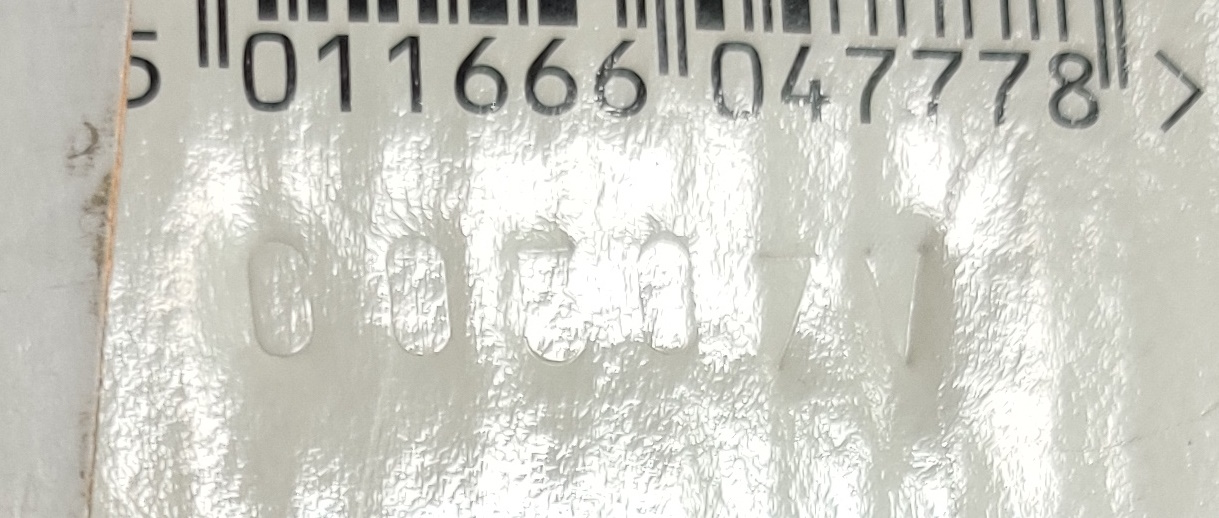
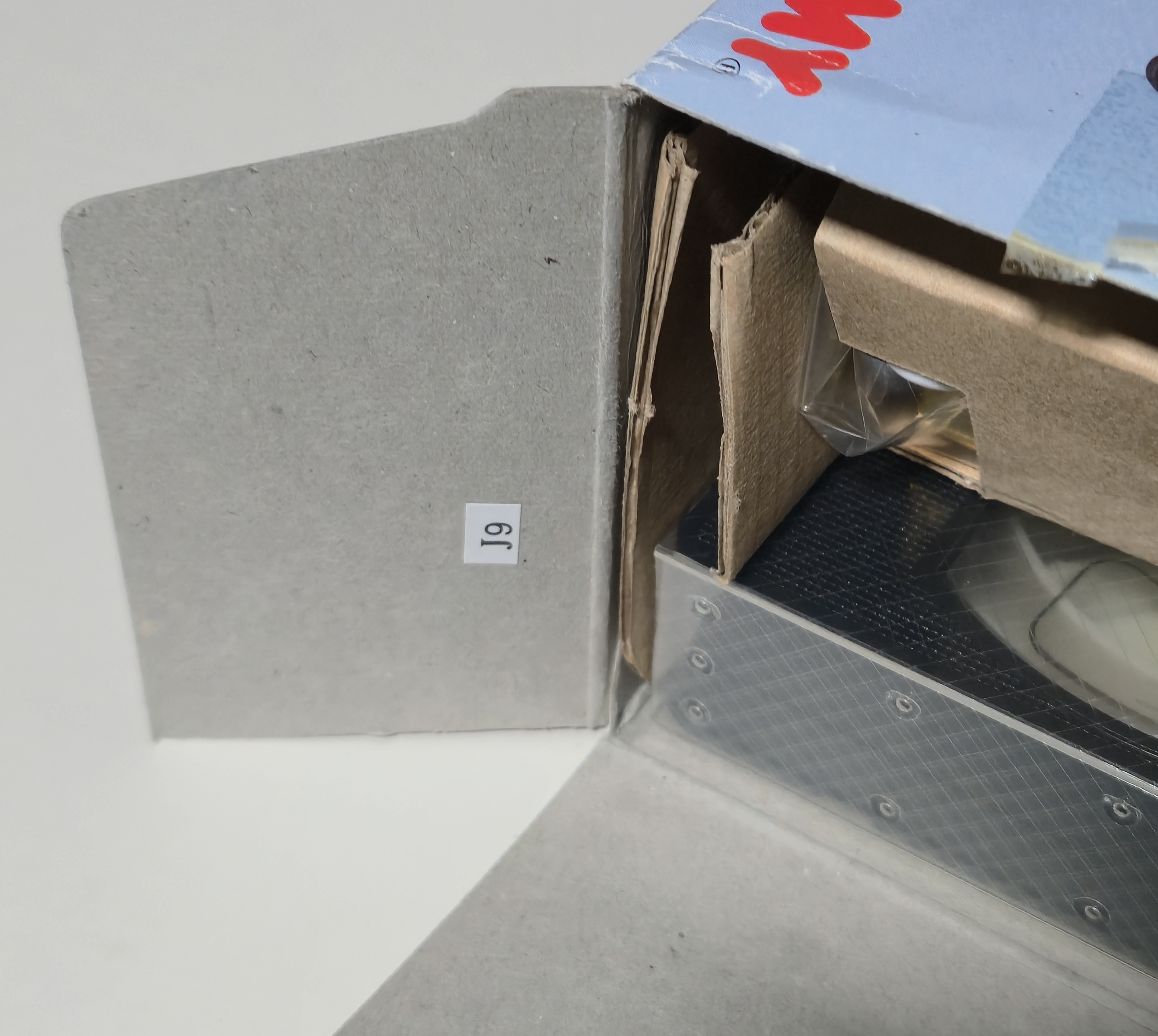
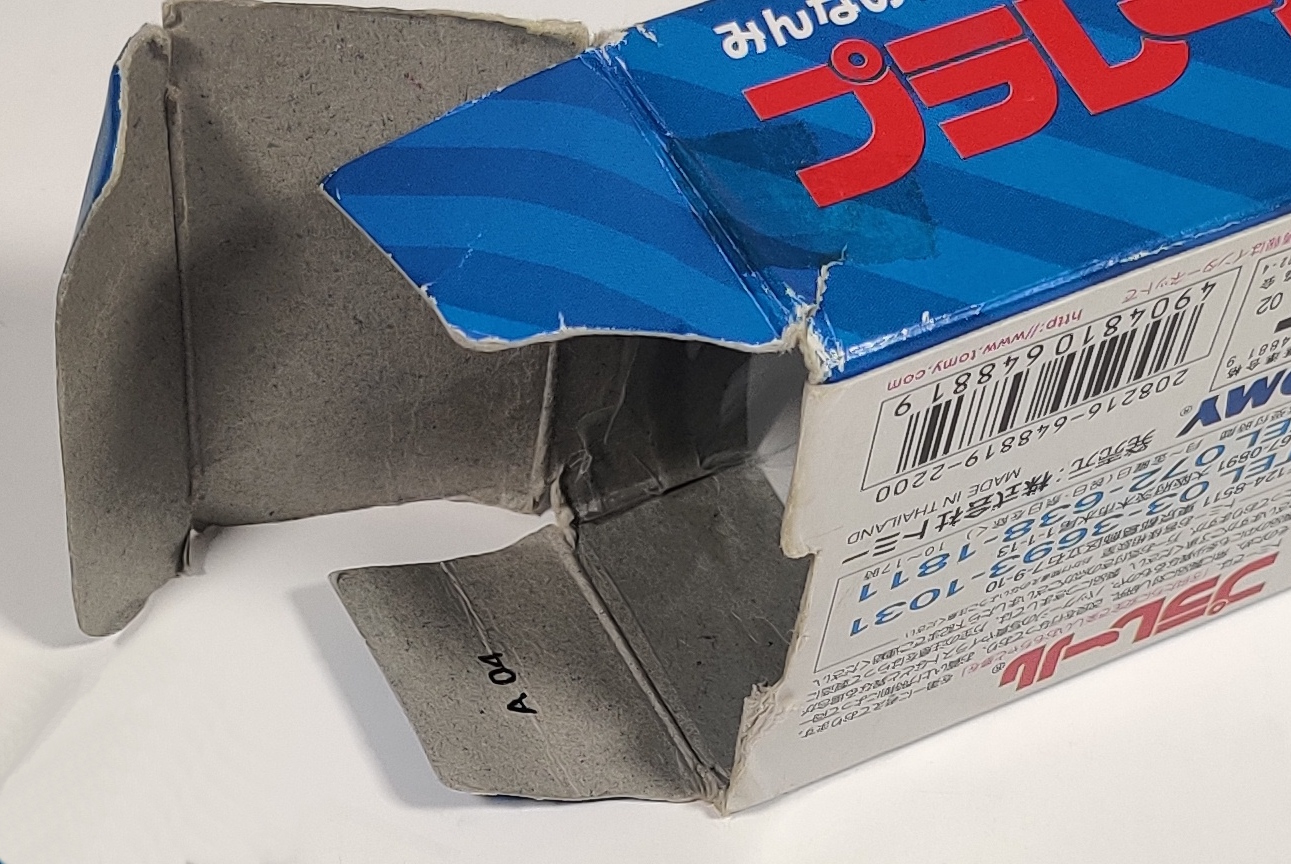
In the late 1990s and early 2000s similar marks began to appear in the packaging itself. In the later 2000s boxes began having the specific date the components inside were packed up in the box and sealed at the factory impressioned into the cardboard near the ST mark, and the contents will date to around or a little bit before this time. If you are concerned about having track or trains that were produced at the appropriate time for a boxed set, this mark is the most accurate "cutoff" for the production period of your particular copy. Some late 1990s boxes are marked with stickers and some Motor Road & Rail and early 2000s Thomas-series train boxes have ink stamps on the inside of one of the box flaps.
Box marks
Since at least 1970 Tomy has marked pretty much all boxes they print with a year of printing in one way or another, typically with a letter and number code. If you encounter one of these marks outside of these ranges, extrapolate the ranges out and if it seems to reasonably line up with when you believe the toy was released, there's a good chance that that is indeed the year of the box's printing. Before 1970 boxes were marked with a TP code, but there is not a clear pattern of the numbering. The Plarail Museum has the most complete list of TP numbers to cross-reference. Some Toy Town toys use TC codes.
| Numbering series | Known box marks... | Equates to... | Notes | Example |
|---|---|---|---|---|
| G series | G-19 to G-23 G-24 G-25 to G-27 |
October 1970 to September 1975 October 1975-February 1976 March 1976-February 1979 |
Numbering seems to increment around October until 1976 |
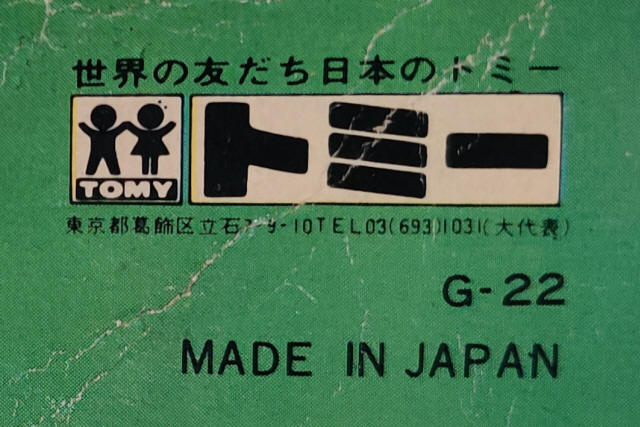 |
| M series | M-20 to M-22 M-28 |
October 1971-September 1974 March 1979-February 1980 |
Seen on export Freerail, Dead Heat and other Tomy games |
 |
| N series | N-21 to N-23 N-24 N-25 to N-36 |
October 1972-to September 1975 October 1975-February 1976 March 1976-February 1988 |
Plarail begins using this schema in the 80s after the MS series, some other Tomy toys used it in the 70s |
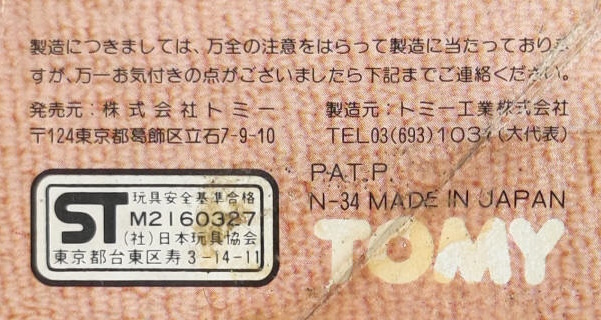 |
| T series | T-22 T-34 |
October 1973-September 1974 March 1985-February 1986 |
Used on Potch, early-mid 1970s Plarail |
 |
| MS series | MS-28 to MS-32 | March 1979-February 1984 | I.E. MS-30 is from March 1981 to February 1982 |
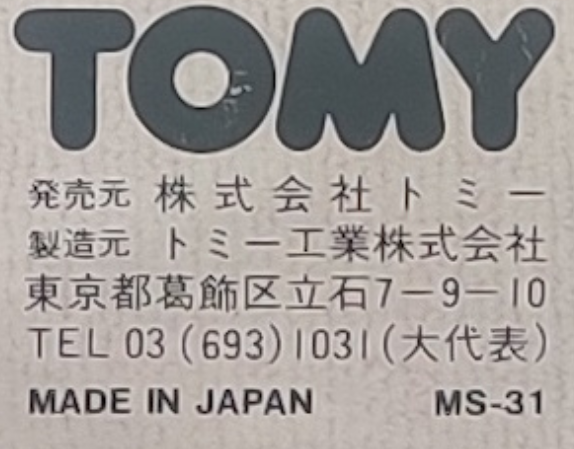 |
| TT series | TT-36 | March 1987-February 1988 | Seems to only be used in 1987 |
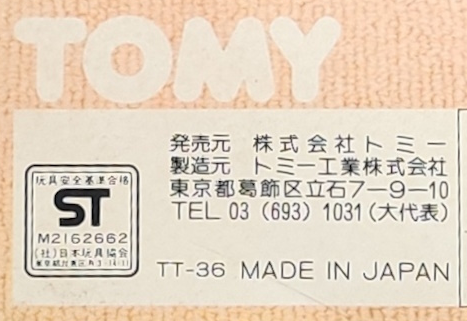 |
ST marks
On most Japanese toy boxes since 1971/1972 ST or Safe Toy marks are included that tell the toy's manufacturer and when it passed safety testing. Originally, they included a longer designation number that included the last digit of the Showa year. The first three digits of the code relate to the company that made the toy (Tomy's is 216, Bandai's 131, etc), the fourth digit the last digit of the Showa year, and the last three the specific product's qualification number. This style was in use from 1971 to 1987 (Showa 46 to 62 - add 25 to the Showa year to get the last two digits of the Gregorian year), so some toys have two possible years based on their fourth digit - the overall style of the rest of the packaging or known approximations of production era should be sufficient to differentiate any Tomy toy, and probably most other ST marked toys as well.
Beginning in 1987 and more widespread in 1988, the ST mark printed on boxes changed to more prominently show the last digit(s) of the year in the ST box.

